US energy pipe and tube market – where to now?
Supervisory control systems for the future.
GLOBAL MARKETS
Steel continues to be a pillar of the global trade landscape.
SPECIAL STEELS
Nant de Drance: a giant rechargable battery.
Since 1866
www.steeltimesint.com

March 2024 - Vol.48 No2
PIPE
TUBE AND
DIGITALIZATION
DECARBONIZING IN 2024







EDITORIAL
Editor
Matthew Moggridge
Tel: +44 (0) 1737 855151 matthewmoggridge@quartzltd.com
Assistant Editor
Catherine Hill
Tel:+44 (0) 1737855021
Consultant Editor
Dr. Tim Smith PhD, CEng, MIM
Production Editor
Annie Baker
Advertisement Production
Carol Baird
SALES
International Sales Manager
Paul Rossage paulrossage@quartzltd.com
Tel: +44 (0) 1737 855116
Sales Director
Ken Clark kenclark@quartzltd.com
Tel: +44 (0) 1737 855117
Managing Director
Tony Crinion
tonycrinion@quartzltd.com
Tel: +44 (0) 1737 855164
Chief Executive Officer
Steve Diprose
SUBSCRIPTION
Jack Homewood
Tel +44 (0) 1737 855028
Fax +44 (0) 1737 855034
Email subscriptions@quartzltd.com
Steel
Published

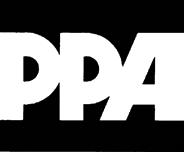
2 Leader By Matthew Moggridge.
4
News round-up
The latest global steel news.
7 USA update Politicians oppose Nippon plans.
10
Latin America update Deacero’s new minimill and shredders.
13
India update Banking on capex.
17
Iron ore Ferrexpo undaunted by Ukraine War.
18
Global markets Trends and policies.
CONTENTS – MARCH 1
Decarbonization
22 Challenges and strategies.
29 Redrawing the map.
32 Decarbonizing in 2024: from both sides of the pacific.
38
Special steels
Nant de Drance: a gigantic rechargeable battery.
42 Digitalization
Supervisory control systems for the future.
46
Tube & pipe
Where to from here?
50
Perspectives: Woodings
Strong solutions, strong business.
52 History
A vanished plant Part 2, 1900-2009.

18
www.steeltimesint.com
Times International is published eight times a year and is available on subscription. Annual subscription: UK £226.00 Other countries: £299.00 2 years subscription: UK £407.00 Other countries: £536.00 3 years subscription: UK £453.00 Other countries: £625.00 Single copy (inc postage): £50.00 Email: steel@quartzltd.com
by: Quartz Business Media Ltd, Quartz House, 20 Clarendon Road, Redhill, Surrey, RH1 1QX, England. Tel: +44 (0)1737 855000 Fax: +44 (0)1737 855034 www.steeltimesint.com Steel Times International (USPS No: 020-958) is published monthly except Feb, May, July, Dec by Quartz Business Media Ltd and distributed in the US by DSW, 75 Aberdeen Road, Emigsville, PA 17318-0437. Periodicals postage paid at Emigsville, PA. POSTMASTER send address changes to Steel Times International c/o PO Box 437, Emigsville, PA 17318-0437. Printed in England by: Stephens and George Ltd • Goat Mill Road • Dowlais • Merthyr Tydfil • CF48 3TD. Tel: +44 (0)1685 352063 Web: www.stephensandgeorge.co.uk ©Quartz Business Media Ltd 2023 ISSN0143-7798 Cover photo courtesy of Superior Machine. Installation of a new tilt platform. Superior is now part of the Woodings Equipment Group
March 2024
The best conference of 2024? You bet it will be!
 Matthew Moggridge Editor matthewmoggridge@quartzltd.com
Matthew Moggridge Editor matthewmoggridge@quartzltd.com
The Future Steel Forum 2024 takes place in June in Stockholm (18-19 June). This year’s event promises to be incredible, amazing, brilliant and, dare I say, the best yet. Why? Because we’re in the Swedish capital for good reason. The Swedish steel industry is leading the way when it comes to decarbonizing the steelmaking process. Both SSAB with its HYBRIT initiative and H2 Green Steel are based in Sweden. So is Ovako and all three are pushing the envelope when it comes to making fossilfree or ‘green’ steel a reality – something we all talk about and we’re all working towards, but let’s just say the Swedes are way ahead of the game. They are the pioneers of green steelmaking and should be applauded. If you’re interested in hearing about what they’re doing and would rather hear it live and from the horse’s mouth, then the Future Steel Forum is for you and I would strongly suggest you register now. As I write this the programme is hours away from ‘going public’ and I can say now that I have met with SSAB, H2 Green Steel and Ovako in Stockholm and they’ve all agreed to speak on Day One of what I can assure you will be the best Future Steel Forum to date.
And the Swedes are not alone. We have presentations from ArcelorMittal, Tata Steel Europe, Tata Steel India, JFE Steel from Japan and many more.
How do we define green steel? It’s a good question and one based on the need for standardisation as a future world hoves into view, where steelmakers around the world start to make claims about the products they produce which might be false or in some way ‘economical with the truth’. I’m not for one minute saying steelmakers are corrupt, of course they’re not, but if a steel end user wants ‘green steel’ it needs a certified product that meets its demands and that’s where standards come into play. We have a discussion panel on this very subject at the 2024 Future Steel Forum and we have big names on the panel ready to discuss it. There is also a panel on direct reduced iron (DRI) featuring all the leading global companies in the sector: Midrex, Energiron and HYBRIT.
This year’s Forum is different, very different, and you would be advised to register now for what I know will be the best conference of 2024. To register, visit https://www.futuresteelforum.com

2 www.steeltimesint.com March 2024 LEADER
aic group_half page.indd 1 07/03/2024 11:07

























#turningmetalsgreen




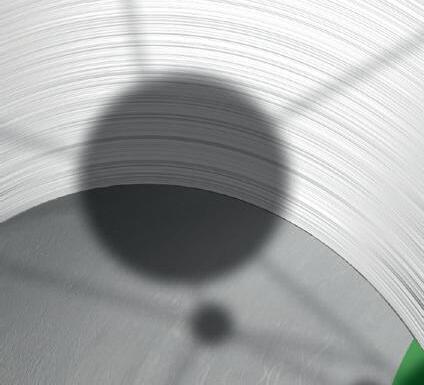

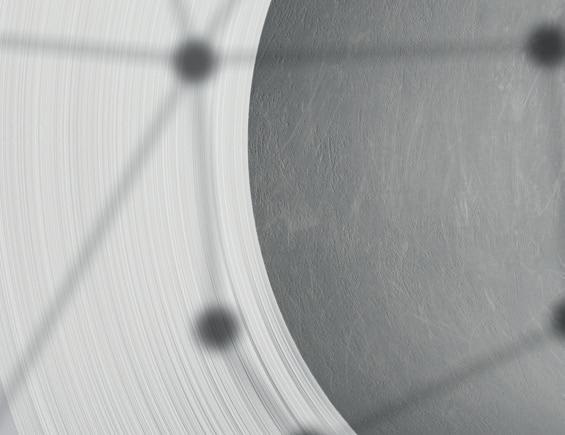













At SMS group, we have made it our mission to create a carbon-neutral and sustainable metals industry. We supply the technology to produce and recycle all major metals. This gives us a key role in the transformation towards a green metals industry.


ArcelorMittal's Zenica steel plant in Bosnia suffered a loss of $88.2 million in 2023, with long-term debt up 400%, it said last month. The results were due to a 12% annual drop in demand, a 20% rise in electricity prices and metal prices on the global market down 22%, the Bosnian business added. "As our 2023 financial results published today show, ArcelorMittal Zenica has found itself in a very challenging situation," the company said, adding that it did not expect market conditions to improve in the coming months.
Source: Business Standard, 23 February 2024.

India Ltd. has drawn up a road map to cut emissions by 20% from 2021 levels by the end of the decade, chairman Aditya


German steel manufacturer
Salzgitter Flachstahl has signed a 10-year power purchase agreement with Octopus Energy Generation. Under the agreement, Salzgitter Flachstahl, a subsidiary of Salzgitter AG, is to be supplied with 126,000MWh of clean energy per year generated from Octopus’ Schiebsdorf solar farm in Brandenburg. Starting when the project is commissioned later this year, it will both secure more clean electricity and provide a hedge against rising electricity costs for Salzgitter Flachstahl, while underpinning its objective of producing green steel.
Source: PEI, 23 February 2024.
Mittal said in the company’s first Climate Action Report. The firm aims to significantly enhance its use of renewable energy to meet 100% of its grid electrical energy needs by 2030. Furthermore, it plans to maximise the utilisation of the scrap mix in total steelmaking capacity, increasing it from the current 3%-5% to 10%.
Source: CNBC, 25 February 2024.

Ukrainian drones hit a major Russian steel factory overnight, causing a large fire, a Kyiv source said on 24 February, the second anniversary of Russia's fullscale invasion of Ukraine. The governor of Russia's Lipetsk region identified the plant as one in the city of Lipetsk, some 400 km north of the Ukrainian border, that is responsible for about 18% of Russian steel output. He said a fire apparently caused by a drone strike had been extinguished at the plant, operated by Russian steelmaker Novolipetsk (NLMK), and there had been no casualties.
Source: Reuters, 24 February 2024

Switzerland-based Terra Quantum is collaborating with South Korean steel manufacturer POSCO Holdings to deploy quantum AI for optimizing steel production, specifically focusing on

Liberty Primary Metals
Australia (LPMA), a subsidiary of British steelmaker Liberty Steel Group, will install a 160-ton low-carbon emission electric arc furnace at its Whyalla steelworks. The new electric arc furnace will take Whyalla's steelmaking capacity to more than 1.5Mt/ yr. The electric arc furnace programme will also receive $63 million in funding from the Australian government.
Source: Yieh Corp Steel News, 25 February 2024
POSCO’s advanced blast furnaces. The partners will demonstrate the potential of Quantum Neural Networks, aiming to enhance efficiency, and target tangible outcomes such as reduced emissions and energy consumption. POSCO has been digitizing its steelmaking process since 2016 and has been applying technologies such as big data, artificial intelligence, and the Internet of Things to its steelmaking operations.
Source: Green Car Congress, 25 February 2024
Czech steelmaker Liberty Ostrava, a subsidiary of UK-based Liberty Steel, is seeking to negotiate lower prices and volumes with Tameh Czech and has made a takeover offer for the insolvent energy producer, Reuters reports. This would allow the company to restart blast furnace No. 3 at its Ostrava plant. Liberty European upstream business executive director Teuns Victor told Reuters that the company is in the process of finalising a proposal to be sent to Tameh, adding that if the energy supplier does not want to restructure, the next step may be the sale of the blast furnace. Source: GMK Center, 28 February 2024.
4 NEWS ROUND-UP
ArcelorMittal Nippon Steel

ArcelorMittal Brasil has entered into a memorandum of understanding with Petrobras, a Brazilian oil and gas producer. The collaboration is geared towards exploring potential business models within the low-carbon economy, encompassing areas such as low-carbon fuels, hydrogen, renewable energy production, and carbon capture and storage (CCS). The focal point of the partnership revolves around joint efforts to establish a carbon capture and storage hub in the state of Espírito Santo.
Source: Chem Analyst, 28 February 2024.


JSW Steel has taken the step to incorporate a new whollyowned subsidiary, JSW Green Steel Ltd, on 27 February in Mumbai. The move, claims the company, underscores its commitment to green initiatives, focusing on the production of hot-rolled and cold-rolled steel products. The subsidiary, with an authorized capital of Rs 500,000, will manufacture hot-rolled and cold-rolled steel products, essential in various industries, including automobile, agriculture, construction, and home appliances.
Source: BNN Breaking, 29 February 2024.

Tata Motors has delivered its next-generation, green fuel-powered commercial vehicles to Tata Steel. The fleet includes Prima tractors, tippers and the Ultra EV bus, powered by Liquefied Natural Gas (LNG) and electric technologies. The vehicles were flagged off by Tata Steel’s chairman, N Chandrasekaran, as part of the Tata Group’s founder’s day celebrations in Jamshedpur. The vehicles were handed over to Tata Steel’s delivery partners for transporting steel products and raw materials, a company press release stated.
Source: ET Auto, 4 March 2024.

India is looking at developing its own pure-hydrogen based DRI to be used in the production of green steel. The process will be ‘unique to the country’, and the detailed project report ‘is under scrutiny’ across ministries, a senior government official aware of the discussions, told The Hindu Business Line. “This technology is still developing and some of the ministries – such as steel and MNRE – and industry players such as integrated steel makers and secondary steelmakers, are working together to get the pilots going on-ground,” the official said, requesting anonymity.
Source: The Hindu Business Line, 5 March 2024
this month, in what
the company claims is a ‘ground-breaking venture in line with its commitment to sustainability and India’s targets of achieving net zero carbon emissions.’ Shri Jyotiraditya Scindia, the union minister of steel and civil aviation, commented: ‘‘This path-breaking green hydrogen initiative will make the steel sector greener and more sustainable.’’
Source: Hydrogen Central, 5 March 2024

South Korea’s Hyundai Steel Co. is expected to resume steel production in Russia two years after it took its
plant offline in the country amid the country’s invasion of Ukraine, which later forced its auto-making sibling Hyundai Motor Co. to sell its factory to a Russian company. According to steel industry sources, Hyundai Steel has decided to restart its automotive steel sheet plant in St. Petersburg, which has remained idle for about two years.
Source: The Korea Economic Daily, 6 March 2024
JSW Steel has picked Robert Simon as the chief executive officer of the steelmaker's US unit. Simon will lead the overall business, comprising slab, coil, pipe and plate production, and sales at Baytown and Mingo Junction, the company said in a statement on 6 March. He will report to the respective boards of both the subsidiary companies of JSW Steel, the company stated. Source: Business Today, 6 March 2024
EDITOR'S NOTE
In our February digital issue, Yushan Lou, lead author of 'China's hydrogen strategy: national vs regional plans' (p.28) and research associate at the Center on Global Energy Policy, Columbia University, SIPA, was not credited on the feature. We apologise to Yushan for this error.
5 NEWS ROUND-UP
Jindal Stainless commenced the first usage of green hydrogen in its stainless steel plant in Hisar, Haryana earlier

Towards green steel
Technologies turning steelmakers’ decarbonization goals into reality.
Jet Vapor Deposition (JVD): Sustainable, highquality and cost-effective steel coating
The JVD line introduces a technological breakthrough in the steel coating of advanced high resistant steel grades difficult to galvanize by hot dipping. This genuine alternative to Electro-Galvanizing and Hot-Dip-Galvanizing considerably reduces the cost of galvanized steel and provides multiple advantages when it comes to quality, speed and OPEX. Developed for ArcelorMittal with the help of our experts, John Cockerill is in charge of commercializing this unique technology worldwide.
Electrical Steel Processing Technologies to produce the steel grades of tomorrow
Our E-SiTM equipment and processing lines are designed for the production of strong, ultrathin, lightweight, and highquality Non-Grain Oriented (NGO) steel grades essential for the future of e-mobility.

Other developments & technologies aiming at decarbonizing the steel industry:
VolteronTM: CO2-free Steel Production Process
Furnace Electrification
Carbon Capture Heat Recovery


Eco-friendly Acid Regeneration Plants
High-performance Acid Regeneration supporting responsible steel making and the circular economy
John Cockerill Industry’s ARPs come with smart plant control systems, provide waste energy recovery and drastically reduce pickling process plants’ fresh acid demands and waste streams in general. What is more, they are providing the lowest emissions in the market.
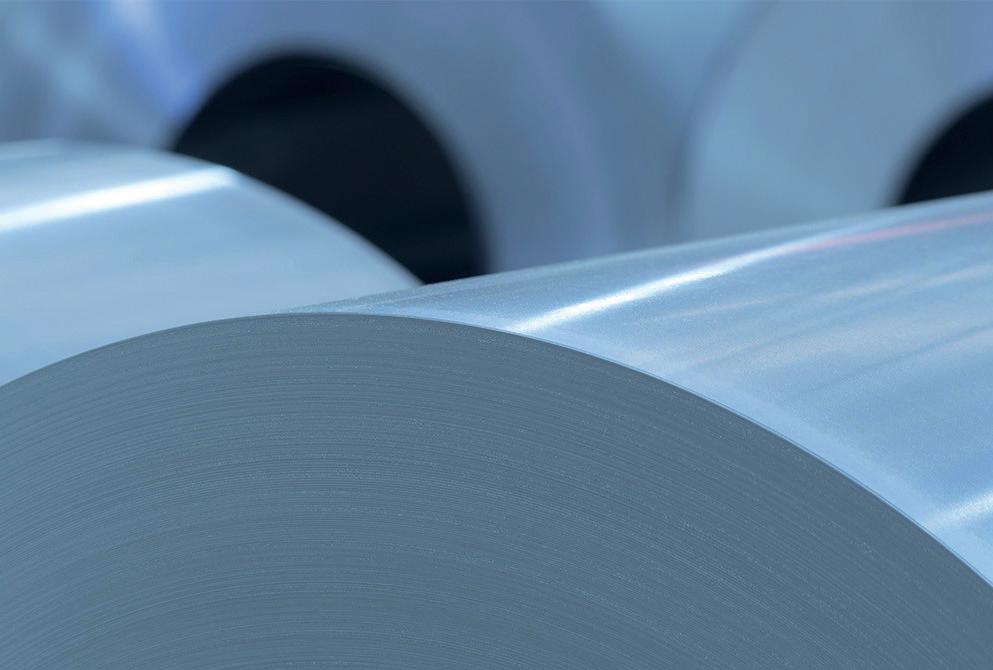
Follow us on
johncockerill.com/industry
JVD (Jet Vapor Deposition) Line
Electrical Steel Processing Technologies
Politicians oppose Nippon plans





The United Steelworkers (USW) union’s opposition to Nippon Steel’s takeover bid of Pittsburgh-based US Steel is now followed by politicians opposing Nippon Steel’s move; Nippon Steel has quoted a purchase price of $14.9 billion which is roughly twice the offer made by US rival steelmaker Cleveland-Cliffs. By
“IT’S not just Nippon’s attractive price offer. Remember, this is an election year and both President Joe Biden and his potential rival Donald Trump (he has, as of writing this update, not yet been officially nominated though he is leading over the other Republican candidates), are reacting to Nippon’s takeover of US Steel,” explained Joseph Marciano, a New York-based analyst. “Then there is the national security element … and no candidate would like to appear less nationalistic when it comes to protecting American interests.”
An otherwise free economy, inherent with opportunities for foreign companies investing in the US corporate sector, nationalism is today on a high pitch, and politicians seem to be outdoing each other in opposing a takeover by a foreign company, although Nippon Steel is based in an allied country.
 Manik Mehta*
Manik Mehta*

JD Vance, a Republican senator, argued that it was “not just this transaction I’m worried about, but that this could be a precedent”, fearing that US Steel would be less responsible to US national security needs and that this would allow Nippon Steel to avoid US tariffs on imported steel through the purchase. He has called for a blanket ban on any foreign buyer of a US company that benefitted from the tariffs. Foreign companies, keen to access the US market, should engage in Greenfield investments.
Former President Donald Trump has vowed to block Nippon Steel’s acquisition of

US Steel.
“I would block it instantaneously. Absolutely,” Trump said after meeting the president of the Teamsters labour union, which represents workers in the transportation industry. “We saved the steel industry. Now, US Steel is being bought by Japan. So terrible.”

USA UPDATE 7 www.steeltimesint.com March 2024
*US correspondent, Steel Times International



SLAG DETECTION SYSTEM
DELIVER IMPROVED YIELDS, HIGHER-QUALITY STEEL AND REDUCE COSTLY DOWNSTREAM PROCESSING ON THE BOF/EAF STEEL MAKING
The high-resolution Slag Detection System (SDS) thermal imaging camera detects the transition between steel and slag and has been specifically designed to survive in harsh operating conditions, whilst utilising a particular wavelength to reduce obscuration caused by smoke and fumes.
Suitable for operators of secondary steel making vessels including stainless steel, SDS can also be used in other smelting operations such as copper and platinum. Its automatic operation ensures that only the predefined amount of slag is carried over before an alarm is triggered.

GET THE BENEFITS:


SDS is AMETEK Land’s definitive solution for monitoring and reducing slag carry-over in steel production facilities whilst saving money and improving operator safety.

Automatic detection and tracking accurately identifies the stream, reducing background interference
Accurate detection independent of charge weight
Fully automatic operation and clear alarm notifications
Improved connectivity through the use of Open Data Interface





























MWIR-640 SDS CAMERA TEMPERATURE RANGE 500 to 1800 °C / 932 to 3272 °F
ACCURATE. SLAG & STEEL. DETECTION.
IMAGEPro SDS 2.2 Thermal Software LEARN MORE: WWW.AMETEK-LAND.COM | LAND.ENQUIRY@AMETEK.COM Proudly exhibiting at:

Biden’s election strategists face pressure with the growing number of Republicans opposing the Nippon Steel acquisition. Biden has in the past underlined the importance of US alliances and has welcomed foreign investment; nevertheless, he knows Nippon’s acquisition would anger the USW which had endorsed Biden’s 2020 candidacy and wields a constituency of over a million members, with many thousands in swing states Ohio, Pennsylvania, Michigan, Wisconsin, etc.
While foreign investments for new US factories were welcomed months back, Nippon Steel’s venture has rung alarm bells among politicians over security issues. Foreign investors can generally benefit from the administration’s massive infrastructure allocations of roughly $3.5 trillion, combined with subsidies.
Experts argue that tariffs on imported steel would draw foreign companies to invest in production in the US, reminding that Japanese carmakers invested in the US in the past; former President Trump in 2018 imposed 25% tariffs on imported steel and Biden continued with the tariffs, though he reached agreement with the EU replacing tariffs on European products with quotas, extending the arrangement until 2025. US Steel’s chief executive David Burritt had also remarked that his company benefitted from ‘accelerating de-globalization’; other countries also reviewed their risks of growing interdependence.
Meanwhile, both Nippon Steel and US Steel, trying to allay doubts in the US, said that they would submit their agreement to the Committee on Foreign Investment in the US (COFIUS) which is chaired by Treasury Secretary Janet L. Yellen, to examine if the
deal would affect any national security interest.
However, COFIUS scrutiny, guarded and discussed by responsible members of the agency, is a protracted process and the wheels move slowly. Also, the deliberations weigh the political implications of such a sale, and US intelligence’s assessment of Nippon Steel.
Some critics object to national interests being put in jeopardy, but others argue that the US military uses roughly 3% of total domestic steel production, according to Pentagon data; modern fighter systems today consume less steel than in the past, using more of materials such as titanium and aluminium.
Besides, the Defense Department does not directly purchase any materials from US

Steel, though the latter has said that some customers, with defense and commercial businesses, may use the company’s raw steel for defense hardware.
COFIUS has taken controversial stands on deals with Chinese companies. Japan, however, is considered a US ally. Also, Nippon Steel is known to have some stakes in eight US steel companies.
Nippon Steel representatives have been talking to US lawmakers to allay their concerns, promising that US Steel would remain in Pittsburgh, with its name intact, and they would honour the steelworkers’ collective bargaining agreement. Nippon Steel, operating 11 blast furnaces, is expected to improve the efficiency of US Steel’s furnaces and also reduce the carbon footprint.
US Steel had spurned the nearly $ 8 billion offer made by Cleveland-Cliffs which,
as details now emerge, had come close to winning over US Steel.
Nippon Steel, which eventually won the bid, was not, apparently, interested in other plants in the region but in US Steel’s minimills in Arkansas and the latter’s iron-ore mining operations in Minnesota.
Nippon originally estimated the value of US Steel’s modern electric arc-furnace plants and the mines at $ 9.2 billion, according to regulatory filings; in late September, it indicated that it had bid at $ 9.5 billion. Its nearly 15 billion dollar offer, made two months later, was finally accepted.
But US Steel also had some concerns about Nippon Steel; David Burritt had called, two days before the deal’s finalization, Nippon’s executive vice president Takahiro Mori, to get assurance that Nippon would work with COFIUS. Nippon finally agreed on ‘all actions required’ to obtain COFIUS’ clearance, if it did not hurt its business.
Indeed, both companies sought the COFIUS review even before the Biden administration called for ‘serious scrutiny of the deal and the opposition by lawmakers of both parties.
Meanwhile, US steel imports totalled 2,082,000 net tons (NT) in December 2023, including 1,614,000 NT of finished steel (+ 2.6% and 7.7 respectively) over November 2023. For the year 2023, total and finished steel imports were 28,156,000 and 21,694,000 NT, down 8.7% and 14.1% respectively over 2022, the American Iron and Steel Institute (AISI) reported.
The top 2023 suppliers were Canada, Mexico, Brazil, South Korea and Japan. �

USA UPDATE 9 www.steeltimesint.com March 2024




Deacero’s new minimill and shredders

Mexican long steel company, Deacero, has announced investments in a new minimill and shredders, demonstrating its aim to reinforce its competitive advantages.
By Germano Mendes de Paula*
DEACERO, a leading Mexican long steel company, fully controlled by the Gutiérrez family, announced late last year investments in the construction of its fourth minimill and the addition of five shredders. However, before analysing these projects, it is important to examine Mexico’s long steel market. According to the country’s National Chamber of Iron and Steel Industry (Canacero), long steel output grew from 8.6Mt in 2017 to 9.5Mt in 2022 (Graph 1). Meanwhile, imports remained relatively stable around the 1.7Mt plateau, while exports increased from 1.4Mt to

1.9Mt, respectively. Therefore, apparent consumption rose from 8.8Mt to 9.3Mt from 2017-2022.
In 2017, Mexico had net imports of 240kt in terms of long steel products. In 2020, it reached net exports of 580kt, but this value reduced to 190kt in 2022. Deacero’s announced investments can be understood as a means of maintaining (and even improving) its prominence in the growing Mexican long steel market.
Current operations
Deacero was established in 1952 as a

modest business employing 12 people installing wire fences. The following year, it began to manufacture some steel wire products. The enterprise became increasingly devoted to wire products as it grew. In 1981, the company decided to start producing its own steel, and for that purpose, it launched its first minimill in Saltillo.
In 1997, Deacero bought its second minimill, in Celaya. Its third mill, located in Ramos Arizpe, started-up in 2011. Although the company’s expansion in steelmaking has been based on greenfield projects rather than acquisitions of existing crude steel capacity, it has purchased many downstream facilities, including in the US.
Today, Deacero operates three minimills (with roughly 4.5Mt/yr capacity) and 14 wire plants (1.4Mt/yr). Celaya is able to produce 2.8Mt/yr of billets and 2.7Mt/ yr of wire rod and rebar. Ramos Arizpe’s capacity consists of 1.5Mt/yr of billets and blooms and 1Mt/yr of rebar, merchants, and beams. Billet is no longer produced in Saltillo, which has a capacity of 600kt/ yr of wire rod. Deacero’s product portfolio comprises wire rod, drawn products, rebars, bars, small sections and large (structural) sections. It has also 30 distribution centres in North America.
Deacero has 21 scrap processing centres,

www.steeltimesint.com March 2024 LATIN AMERICA UPDATE 10
Professor in Economics, Federal University of Uberlândia, Brazil. E-mail: germano@ufu.br
*
Graph 1. Mexican long steel market, 2017-2022 (Mt)

which have a combined capacity of 4Mt/yr, doing business with more than 1,000 suppliers. It consumed 3.8Mt of scrap in 2022, which was equivalent to 43% of the Mexican steel industry. Consequently, it is the country’s largest ferrous scrap recycler. According to the company’s sustainability report, shredded scrap was equivalent to 36% of metallic charge in 2022.
Deacero’s strategy can be summarised as a long steel maker, fully based on minimills, with a large degree of backwards vertical integration (scrap processing) and a degree of forward verticalisation (distribution centres). The investments announced last November aim to reinforce its current competitive advantages.
New plant and new shredders
In September 2023, Deacero announced plans to invest $1bn in production capacity expansion of its mill located in Ramos Arizpe. At the time, the project would expand the minimill capacity by 1.2Mt/yr, of which 700kt/yr would consist of small and large sections from 8” to 27”, 300kt/yr of wire rod and rebar. Nevertheless, when the project was formally announced in November 2023, it consisted of a new 1.5Mt/yr minimill for production of sections up to 27”.
The new mill will be strategically located in Ramos Arizpe, very close to an existing minimill for small sections (from ¼” to 10”). Danieli will supply the key equipment (from scrap processing to melting and secondary refining, beam blank and billet continuous casting, a medium-heavy section mill, a reheating furnace and mill stands). The steelmaking facility will include a 150-tonne capacity EAF and a twin ladle furnace secondary refining station. The continuous casting machine will deliver 180x180mm and 280x220mm billets/blooms, 480x150mm mini-slabs, and 280x220x90mm and 480x380x90mm beam blanks. Plant start-up is scheduled for Q1 2026.
Also in November 2023, Deacero announced the acquisition of five new shredders from Danieli. Four will operate 2000hp (capable of processing 50tonnes/hr), while the fifth, equipped with 4000hp, will guarantee 100tnnes/hr. Each new plant will feature shredder machines, ferrous scrap cleaning, and non-ferrous separation lines. This will consolidate Deacero’s leadership in scrap processing in Mexico.
Finally, and more importantly, Deacero is implementing a decarbonization plan, which aims to lower CO2 emissions by 56% in steel shops and rolling mills. This goal includes direct emissions (scope 1) and indirect energy consumption (scope 2). In 2022, its emission intensity reached 0.24tCO2/t liquid steel produced in the steel mills (excluding rolling mills), which is substantially lower than the world average of 1.9t CO2/t, according to worldsteel. The company’s target is to decrease its emission intensity to 0.14tCO2/t liquid steel from 2027 onward. As a fully EAF-scrap based producer, Deacero is in a very comfortable situation to be a player in the decarbonization era.
Preparation Technologies for Metallurgy
















Tailor-made Solutions

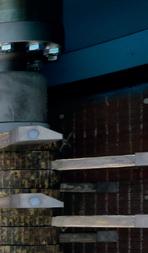


• Preparation of pellets and micropellets
• Sinter mix preparation
• Recycling of valuable residues like dusts, ashes, sludges, slurries
• Fine grinding
• Preparation of carbon paste for graphite electrodes, anodes, cathodes
• Coal preparation :»
• eirich.de

11 www.steeltimesint.com March 2024 LATIN AMERICA UPDATE
eirich_half page vertical.indd 1 07/03/2024 11:08

The most technically advanced coil joining equipment available. Period.




Guild International can design and build the welding machinery you need to keep your coil processing lines up and running smoothly and profitably. We are the world leader in supplying highly-engineered coil processing equipment known for reliability and performance. Contact us today to begin designing the perfect coil joining equipment for your processing lines.

For more information, visit our website at www.guildint.com or call +1.440.232.5887
World Leader in Coil Processing Equipment for the Steel Processing, Tube Producing and Stamping Industries Since 1958
Banking on capex
Increased investment in India’s steel industry continues to drive demand, and enhance operating capacity. By Dilip Kumar Jha*

SLIPPING by 9% in the financial year (FY) 2022-23 (April-March), India’s government-owned Central Public Sector Enterprises (CPSEs) have secured INR 133 billion (~INR83.2 = US$1) capex for FY 2024-25. This allocation aims to expedite the completion of stalled and under-construction projects and increase demand for additional allocations to help the country achieve an overall production capacity of 300Mt/yr by 2030-31, as envisaged in the National Steel Policy, 2017. During FY2022-23, steel CPSEs achieved a capex of INR 105.26 billion, the highest in the past five years, out of the total allocations of INR 115.9 billion.
Against the capex target of INR 103.01 billion for FY 2023-24, steel CPSEs achieved a figure of INR 54.15 billion, i.e. just 52.6%, during April-November 2023. The capex target is being monitored regularly for the timely completion of projects and to achieve the physical and financial milestones. The government is making all efforts to ramp up production of crude and specialized steel to make India ‘aatmanirbhar’ (self-reliant) and reduce imports. The capex on CPSE projects yields a multiplier effect on private investment in the core steel production and its upstream and downstream segments.
Additionally, India has approved the inclusion of ‘specialty steel’ under the Production-Linked Incentive (PLI) scheme, with a five-year financial outlay of INR 63.22 billion to promote the manufacturing
of this sector within the country by attracting capital investment and promoting technology upgrades in the steel sector. The government signed a memorandum
of understanding (MOU) with 57 companies, covering 67 applications from 30 companies for different categories of specialty steel under the PLI scheme. The
*India
13 www.steeltimesint.com March 2024
International Estimated steel consumption in India’s various infrastructure projects on completion Project details Volume (Mts) Pradhan Mantri Awas Yojana (Urban+Gramin) 70-80 Bharatmala Project 25.1 Sagarmala Project 23.5 Jal Jeevan Mission 18.5 Expansion of gas pipeline network 12.0 UDAN-100 additional functional airports 8.0 National Solar Mission 4.5-5.0 Metro network in 50 additional citiesSmart Cities MissionSource: Ministry of Steel, Indian government Note: Pradhan Mantri Awas Yojana (Urban+Gramin) Prime minister, housing scheme Major Central Public Sector Enterprises (CPSEs) investment (INR billion) Steel mills 2020-21 2021-22 2022-23 2023-24* Steel Authority of India Ltd (SAIL) 42.83 60.13 54.74 68.00 National Mineral Development Corporation (NMDC) 16.22 11.98 14.01 16.00 Rashtriya Ispat Nigam Ltd (RINL) 7.37 7.39 5.81 7.01 Manganese Ore India Ltd (MOIL) 1.37 2.16 2.45 2.95 Kudremukh Iron Ore Company Ltd (KIOCL) 0.41 0.29 4.23 8.05 Source: Ministry of Steel, Indian government; Financial year (April-March), *Estimated; $1= INR83.2 Indian steel Production^ (million tonnes) Category 2018-19 2019-20 2020-21 2021-22 2022-23 2023-24* Pig iron 6.41 5.42 4.88 6.26 5.86 4.14 Sponge iron 34.71 37.10 34.38 39.20 43.62 29.10 Total finished steel 101.29 102.62 96.20 113.60 123.20 77.78 Source: Joint Plant Committee; ^April-March period; *April-October 2024
correspondent, Steel Times
INDIA UPDATE

PLI scheme is set to commence from FY 2023-24, with funds to be released in FY 2024-25. These companies have committed an investment of INR 295.30 billion with a downstream capacity addition of 25Mt/yr. Also, capex was raised to develop enabling infrastructure to drive demand and enhance the operating capacity of domestic steel mills which have remained between 7782% in recent years.
Among bulk material transportation pipeline projects, the Paradip Slurry Pipeline project by Essar Minmet is expected to attract an investment of $880.31 million and to commence by September 2024.
Similarly, Joda Slurry Pipeline with a capex of $1.06 billion will be completed by June 2024, Joda to Kalinganagar Slurry Pipeline Project with a capex of $405.89 million by December 2026, and NMDC Slurry Pipeline Project Phase 1 with an investment of US$365.53 million will be completed by May 2025. Additionally, private steel mills such as JSW Steel, Tata Steel, and a host of others have announced a substantial capex to benefit from the infrastructure growth.
Mitigating adverse pandemic effects
The large capex across infrastructure development aims to mitigate the impacts of the Covid-19 pandemic, which dampened consumer sentiment (from 2019-end to 2021-end). Governmental and private investors waited for the receding of Covid-19 cases to restart construction work on stalled and under-construction projects. Fresh investment during this period came to near zero across all sectors, including infrastructure development, automotive, and manufacturing, with steel being no exception.

However, the government ramped up investment towards the end of FY202122, especially in the peak demand season towards 2022-end by prioritizing capex across CPSEs to revitalize the Indian economy from the Covid-19-induced contraction. To recover production loss and boost the economy, the capex for CPSEs was allocated to the tune of INR 101.47 billion but spent INR 84.95 billion in FY 2021-22. Given the importance of capex in strengthening infrastructure and enhancing production capacity in the post-pandemic period and the significantly higher targets set for the current year, the government is examining the progress regularly.
Additionally, the government is also addressing the inter-ministerial issues for faster implementation of capex projects. These targets aim to motivate the workforce, enhance India’s steel production, and spur higher growth.
Budget bang
India’s Finance Minister Nirmala Sitharaman, allocated INR 11.11 trillion (~US$133.87 billion) capex for infrastructure creation in the Interim


Budget 2024-25, representing over 11% increase from INR 10 trillion allocated in FY 2023-24. The government aims to achieve a $5 trillion economy by 2024-end, with an enhanced focus on infrastructure. These allocations are intended for the development of projects in housing, roads, railways, and airports, to boost steel demand. According to Ranen Banerjee, partner, and leader for economic advisory at PwC India, these allocations should provide continuity in the pace of infrastructure creation and in bringing down logistics costs in India progressively. Alok Sahay, secretary general of the Indian Steel Association, stated, “The government’s focus on infrastructure development will result in robust steel demand, attracting investments and job creation, leading to unprecedented growth in the next five years.”
Steel is a deregulated sector, and therefore, the government acts as a facilitator by creating a conclusive policy environment for the development of the entire sector.
The National Steel Policy envisions the development of a technologically advanced and globally competitive steel industry, providing an environment to attain selfsufficiency by offering policy support and guidance to domestic producers.
The National Steel Policy aims to achieve a production capacity of 300Mt/yr, crude steel production of 225Mt/yr, and per capita finished steel consumption of 158 kgs by 2030-31.
Presently, India stands at a steel production capacity of around 165Mt/yr, finished steel production of 124Mt/yr, and per capita consumption of 86.7 kgs. �
www.steeltimesint.com March 2024 INDIA UPDATE 14


THERE ARE ONLY BENEFITS WITH OUR ELECTRIC HEATING SOLUTIONS!


Steel is going electric: Are you part of the change?
TEMPERATURES 1,850°C
ZERO CO ²




95% ENERGY EFFICIENCY EMISSIONS
100%
SILENT

Download our litepaper Electric heating in numbers by scanning the QR-code.
PRECISION
TEMPERATURE
+/- 1°C

BIGGER . STRONGER .
BETTER TOGETHER .
WOODINGS AND SUPERIOR HAVE JOINED FORCES!



woodings.com // smco.net

BIGGER.
STRONGER. BETTER FOR YOU.
Superior Machine has joined the Woodings’ group creating the most capable hot metal equipment supplier group in North America. Offering the combined knowledge, engineering, manufacturing, and construction expertise for all your equipment needs.
BLAST FURNACE, BOF, EAF AND CASTER.
Wherever hot metal is produced, you will find equipment from Woodings, Superior Machine, and

Munroe operating at the highest level in the most demanding conditions. Our products and professional installation services reduce downtime and extend campaign cycles.
SOLE SOURCE VALUE.
We can provide you with more value than ever before from concept to installation, service to replacement, our size, scope, and experience gives us a unique ability to help you increase productivity and solve problems.
We are better together. Let us show you.

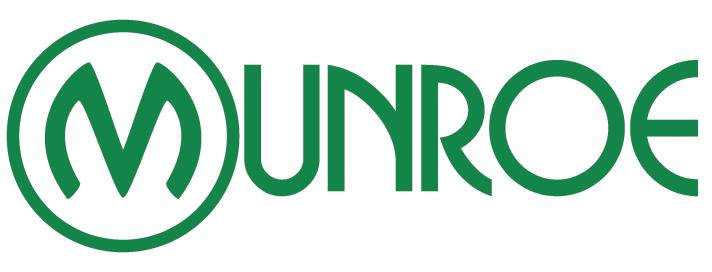
WORLD CLASS EQUIPMENT FOR HOT METAL








Ferrexpo undaunted by Ukraine War

Ferrexpo undaunted by Ukraine War
While the war in Ukraine continues to affect those at the front line in the worst possible way, enterprises operating there have needed to make changes. Michael Schwartz* explains how iron-ore pellet-producer Ferrexpo is rising to the challenge.
MOST immediately, Ferrexpo’s pelletproduction figures for H12023 are 57% higher over H12022, topping 1.96Mt. In this respect, Ferrexpo has two advantages.
First, as the company pointed out to Steel Times International, “Ferrexpo is blessed with high-quality ore reserves, which mean that the average grade of the Group’s iron ore production in 2022 was 65% iron for premium blast-furnace pellets (5.7 Mt) and 67% iron for Direct-Reduction (DR) pellets (353kt). This is significantly higher quality than the industry average.”
Secondly, the company offers DirectReduction (DR) pellets, which obviate the need for sintering, the practice required for 62% of all iron ore consumed last year.
And the effects of the war?
Steel Times International asked Ferrexpo whether the fighting in Ukraine has deterred any further forms of development, exploration or investment. The company pointed out that such activity was halted, Ferrexpo’s regional marketing manager (Middle East) Aly Mansour replying:
“Following Russia’s invasion, Ferrexpo paused its Wave 1 production expansion programme, which would have added 3 Mt/yr of pellet production, in order to focus on supporting staff and local stakeholders, and right-size the business to ensure a continuation of operations.’’
While the image of Ukraine is one of a country that is engulfed in conflict, it should be mentioned that Ferrexpo’s operations
are based in central Ukraine, a region that continues to be served by transport and power infrastructure and is away from the front lines. One factor that has been affected is the transportation of the iron ore. Mansour again: “Our strategy of moving early and right-sizing our business – so that we are more responsive to everchanging circumstances – is working. While our primary seaborne export route through the Ukrainian Black Sea ports has been unavailable since the full-scale invasion, the Group has been able to transport the ore to premium European customers via rail and barge and to export to global seaborne customers via alternate logistics routes.”
Ferrexpo also informed Steel Times International that it continues to assess the cost-effectiveness of alternative seaborne options, notably shipping out of nonUkrainian Black Sea ports. The company is assessing the potential opening of a safe corridor from Ukrainian Black Sea ports and the associated safety and costs.
Green issues have not been forgotten Ferrexpo has not allowed the war in Ukraine to deflect from its drive towards supplying pellets, which have the potential to contribute to the manufacture of lower emission steel. It sums up its achievements as follows: “the Group has been able to upgrade its Scope 1 and Scope 2 carbon emissions reduction target to a 50% reduction by 2030 (previously 30%) and to net-zero by 2050, as well as broaden the
*Iron ore correspondent
Group’s emissions target to include Scope 3 emissions. High grade iron ore pellets, such as those produced by Ferrexpo, are known as a direct charge material, which means they can be placed directly into blast furnaces and do not require the additional sintering process which uses coal. This, added to the high iron quantity, means that Ferrexpo pellets can help reduce carbon emissions by 40% for every tonne of sinter fines replaced with pellets.”
What is more, Ferrexpo points out that DR grade pellets for DR iron/electric arc furnace steelmaking reduce the company’s Scope 3 emissions for steelmaking by 49% for every tonne produced. Such DR pellets represented 6% of the company’s production, itself 50% up over 2021.
Would Ferrexpo look elsewhere?
Aly Mansour answered this question as follows: “Ferrexpo is fortunate to have the licences to some of the largest quality magnetite ore deposits in the world, and established operations with a 50-year heritage. It would be difficult to replicate the quality reserves and operations to produce premium quality iron ore pellets anywhere else. Furthermore, Ukraine is uniquely well-positioned to serve the established MENA and growing European markets.”
The bottom-line comment is his: “We remain a significant contributor to Ukraine’s export economy, representing 3% of total exports by value in 2022.” �
IRON ORE 17 www.steeltimesint.com March 2024
Trends and policies Trends and policies

Steel continues to be a pillar of the global trade landscape, supporting industrial growth and forming the backbone of national infrastructure. India’s steel capacity has now surpassed 161Mt. In the fourth Indian Steel Association (ISA) Steel Conclave, steel secretary Nagendra Nath Sinha highlighted that the steel industry is projected to grow. The steel trade is navigating a sea of trends and policies, including economic shifts, environmental imperatives, geopolitical dynamics, and more. Let’s take a closer look at the global steel trade trends and what shapes trade policies. By Kairavi Mehta*
TRADE policies, specific tariffs, and trade barriers have a significant impact on how the world’s steel trade is shaped. The dynamics of international trade have become even more complex as a result of trade tensions between the major steelproducing countries, which have led to the imposition of tariffs and anti-dumping measures. The need for green steel, rising carbon prices, and new technologies are all driving changes in the global market. Asian manufacturers have to choose between putting money into antiquated coal technology and putting themselves at the forefront of the transformation of the steel industry.
Global issues
The United States has played a vital role in this field by imposing tariffs on imports in order to stand by its own industries. Globally, these policy decisions have an impact on end-user cost structures and the business plans of steel producers. Recently, former US president, and current presidential nominee Donald Trump mentioned in his 2024 presidential
campaign that he would propose a fouryear plan to phase out Chinese imports of essential goods, including electronics, steel, and pharmaceuticals. Steelmaking, in general, has several areas of improvement and vital agendas to look into, especially in terms of reduction in carbon emissions.
Eiji Hashimoto, president of Japan’s biggest steelmaker, Nippon Steel, said in an interview that if the conflict between Russia and Ukraine lasted for a long time, it would have a huge impact on the demand for steel globally. Hashimoto also emphasized that global steel trade will be impacted due to Russia and Ukraine both having a big presence in the market.
Prior to the Ukraine crisis, Hashimoto highlighted three factors that led to the dent in steel demand – China’s slowdown, the global chip shortage, and soaring energy and natural resources prices. These risks have grown bigger due to the Russia-Ukraine conflict and it will have a massive impact on global steel demand. Similarly, the ongoing Israeli-Palestinian conflict is also expected to impact India’s steel industry, said Shri Sanjeev Agrawal,
* Executive director, VK Industrial Corporation Ltd.
the president of the PHD Chamber of Commerce and Industry (PHDCCI).
Policy implications: managing environmental resources
The environmental impact of the steel industry is coming under more and more scrutiny. Trade policies are increasingly incorporating environmental standards as countries make commitments to ambitious climate goals. The future of the global steel trade is expected to be shaped by nations that impose strict environmental regulations, as they will have an impact on sustainability practices, emission standards, and production methods. Adoption of lowcarbon technologies, collaborative efforts, and green practices are critical for ensuring long-term sustainability while aligning with national and international environmental goals.
Similarly, investing in innovation and newer technology is propelling the steel industry to new heights in the Industry 4.0 era. Digitalization, automation, and artificial intelligence are revolutionizing production processes and increasing efficiency. To
GLOBAL MARKETS 18 www.steeltimesint.com March 2024
remain competitive and sustainable, players in the global steel trade need to adjust to these technological developments.
Here are 10 crucial factors that are shaping the global steel trade trends in 2024:
• China’s dominance: No discussion of global steel trade is complete without mentioning China’s formidable presence. The Asian behemoth has long dominated both the supply and demand sides of the steel equation. While China’s mammothsized construction endeavours continue to drive domestic demand, its steel exports have global ramifications, influencing market dynamics and pricing globally. However, in recent years, China has taken steps to reduce excess steel production and address environmental concerns. This shift is upending the conventional narrative, having an impact on both domestic and international steel markets.
The effects on the global steel trade are unavoidable as China navigates its own economic rebalancing. China, as the biggest manufacturer and consumer of steel, continues to play a key part in the global steel trade. China’s economic policies, output levels, and rapidly building infrastructure all have a direct effect on global steel trends.
• Tariffs and trade disputes: Ongoing trade disputes between major steelproducing countries, particularly the United States, have resulted in the imposition of tariffs and trade barriers. These measures have an impact on the flow of steel across borders and add to market uncertainty.
• COVID-19 Impact: COVID-19 has disrupted global supply chains and impacted steel demand. Steel trade has been influenced by lockouts, reduced economic activity, and fluctuations in the construction and manufacturing sectors.
• Infrastructure development: Steel demand is driven by global infrastructure projects, particularly in emerging economies. The emphasis on construction, urbanization, and transportation projects in regions such as Asia and Africa has an impact on the global steel trade landscape.
• Environmental concerns: The growing emphasis on environmental sustainability is having an impact on steel trade trends. Countries are enacting

stricter environmental regulations, which are influencing production methods and material selection in the steel industry.
• Trade balance changes: Changes in the trade balances of major steel-producing and steel-consuming nations have an impact on the global steel market. Changes in manufacturing capacity, export volumes, and import reliance all contribute to changing trade dynamics.
• Technological innovation: The steel industry is being transformed by the adoption of Industry 4.0 technologies such as automation, artificial intelligence, and digitalization. This innovation improves production efficiency, quality control, and overall market competitiveness. In addition, the Indian government has been a proactive catalyst for technological advancement in the steel sector. Initiatives like the ‘National Steel Policy’ emphasize the importance of technology infusion in order to boost competitiveness, improve energy efficiency, and reduce the industry’s environmental footprint. Subsidies and incentives are frequently offered to encourage the adoption of cleaner technologies and best practices.
• Price fluctuations in raw materials: Price fluctuations in raw materials, particularly iron ore and coking coal, have an impact on the cost structure of steel production. Variations in these prices can have an impact on the competitiveness of steel-exporting countries.

• Trade treaties and alliances: Regional and bilateral trade treaties, such as the Comprehensive and Progressive Agreement for Trans-Pacific Partnership (CPTPP) and the Regional Comprehensive Economic Partnership (RCEP), shape the terms of steel trade among participating countries.
• Demand from automotive sector: Steel demand is influenced by the automotive industry’s transition to electric vehicles and lightweight materials. The types and quantities of steel traded globally are impacted as automakers seek innovative materials for sustainability and fuel efficiency.
Roadmap ahead
The manufacturing sector of the steel industry has observed a compound annual growth rate (CAGR) of 7% - 8%, anticipated to drive the increasing demand for it in the sector. On a myopic level, India’s domestic steel demand is estimated to grow annually by 7.5% to reach 128.8Mt in the current financial year. As per the National Steel Policy, India has an ambitious target of installing 300Mt steel capacity by 2030.
Conclusion
Adaptability and foresight become essential as the global steel trade weathers the storms of changing trends and policy impacts. The steel industry’s boundaries are defined by trade laws, technological developments, and geopolitical changes that affect stakeholders, from producers to consumers. It takes a sharp awareness of the world at large and a proactive strategy to take advantage of opportunities when faced with obstacles to successfully navigate complex waters.
Reducing energy use and debris is vital in this industry because it produces a lot of waste and uses a lot of energy. Additionally, the development of cuttingedge technologies aid in the enhancement of steel bar manufacturers’ operations, the reduction of their carbon footprint, and their competitiveness in the world market. Those who embrace innovation, sustainability, and strategic collaboration will emerge as captains of a resilient and prosperous global steel industry in the ever-changing seas of international trade. Innovation and a sustainable approach is necessary for the steel industry to expand.
�
19 www.steeltimesint.com March 2024









DAN IELI T R U E GRE EN ME T A L Buy the Original MIDA–QLP QSP–DUE Danieli Headquarters in Buttrio, Udine, Italy www.danieli.com Italy, Germany, Sweden, Austria, France, The Netherlands, UK, Spain, Turkey, USA, Brazil, Thailand, India, China, Japan @danieligroup

MIDA–QLP
and QSP–DUE
are the winning Danieli direct-rolling technologies for the most competitive production of long and flat green-steel products.
They are the result of the research and continuous improvement profused over 20 years, along with multi-million dollars of investment.


Their unmatched performances have fueled their success worldwide, thanks to lower resource consumption and carbon emissions, unbeaten OpEx, and outstanding product quality.
So, top technology becomes copied technology, the shortest route for competitors that, abandoning their solutions, now try to imitate MIDA–QLP and QSP–DUE Equipment and layout may be copied, but experts know that details make the difference.
Automation and process solutions are not easy to copy, and this will be the experience of anyone trusting in those imitations.
The competitive advantage for our customers, obtained by field results, is the best defense for our technology – more than court rulings protecting our patents.


Danieli offers the best guarantees for speedy learning curves, steady performances, and now Digital Plants with no men on the floor. Buy the Original.
GIANPIETRO BENEDETTI CHAIRMAN OF THE BOARD OF DIRECTORS








Challenges and strategies











The steel sector is a foundation of modern society and is present in many aspects of our lives. The industry has over the last decade been facing increased environmental and climate pressure to lower its carbon footprint while remaining economically competitive. Decarbonizing this sector is challenging but nevertheless key for achieving climate goals. OECD data has shown that the sector accounts for around 6-8% of man-made global emissions




energy sector. There have been efforts to decarbonize iron and steel production globally, and this article examines those challenges along with the strategies available to industry to achieve low-carbon and, ultimately, green steel in the coming decades.
By Aliyu Aliyu1 Dirk Schaefer2, Amire Bdiee1, Peter Warren3 and David Talbot4
1. The road to decarbonization: current status
The global steel industry is a major carbonemitting industrial sector and accounts for 6-8% of global anthropogenic CO2 emissions from the energy sector [1], [2] Decarbonizing this industry globally is essential to meeting the overall goals of the United Nations Paris Agreement (COP21) to limit global warming to well below 2°C above pre-industrial levels [3]. To achieve this target requires immediate action and innovations need to be brought on-stream quickly. Highlighted in the agreement is the urgency of raising ambition for decarbonizing industrial production using ‘breakthrough’ technologies. Steel was specifically mentioned as one of the key industrial sectors where progress in implementing carbon ‘near-zero’ technologies will deliver towards achieving CO2 emissions and global warming goals. It has been calculated that this involves reducing emissions in steel production by 90% from 2020 levels by 2050 [4]. However,
the OECD [2] has highlighted that while the steel industry has made progress in several areas, the sector is not on a trajectory to achieving decarbonization. This involves reducing the current global total of more than 2,800 MtCO2 per year [5]–[7] and is a difficult endeavour as worldwide steel consumption has been growing steadily over the years, driven by demand from economies such as China and India.
In 2019, global steel consumption was 1,800 Mt, an increase of 3% over 2018 consumption[3]. While China is the largest exporter of steel products, Japan is the largest importer fuelled by its strong export vehicle and machinery manufacturing sector[8]. The same can be said for most industrialised countries with a strong export market for steel products. Hence, to achieve decarbonization, the sector requires deep transformation since technological solutions currently available only provide limited mitigation capability [9]. As steel is an internationally traded product any ambitious decarbonization

policies will have international implications. Difficulties include the huge capital outlay in the processes capable of operating in extreme conditions and at massive scale, the nascence of many decarbonization technologies such as carbon capture and green fuel systems which are still at laboratory or pilot stage and scaling them up is an equally huge issue. Fig 1 shows that most green steel projects and initiatives are situated in Global North countries, however, the bulk of demand for steel (though not necessarily all green) will likely be from emerging and developing economies.
These highlight the magnitude of the challenge facing steel if targets are to be achieved to reduce emissions by 90% by 2050 based on 2020 levels. While the steel industry is beginning to tackle the problem, spreading zero-emission steel technologies worldwide requires responding where most of the future steel production will come from. So far, mature countries in Europe, are leading this charge. The steel industry
DECARBONIZATION 22 www.steeltimesint.com March 2024
1 School of Engineering, University of Lincoln, Brayford Pool, Lincoln, LN6 7TS, UK 2 Faculty of Science and Engineering, University of Hull, Cottingham Rd, Hull, HU6 7RX, UK 3 Binding Solutions Ltd, Materials Processing Institute, Eston Road, Middlesbrough TS6 6US, UK 4 CATCH UK, Redwood Park Estate, Stallingborough DN41 8TH, Grimsby, UK
from the

is a focal point of political considerations in most developed nations especially given its central role in climate policy. It is paramount to achieving international targets of COP21 and other multi-lateral agreements. Nevertheless, decarbonizing steel production is not without significant challenges. As a result, this article aims to examine the main issues surrounding the decarbonization of the global steel industry and will assess the possible pathways available for producers to achieve lowcarbon footprint production of iron and steel.
1 Challenges facing the industry’s decarbonization
There are a myriad of economic and technological challenges hampering decarbonization efforts in the global steel industry. While trade barriers, and volatility in raw material prices are wider issues for the sector, the main economic challenge hindering decarbonization initiatives include securing sufficient public and private sector investment to power relevant projects.
1.1 Technological and carbon accounting challenges
There are several technological challenges needed to realise low-carbon steel and these include adequately increasing the energy efficiency of current processes, the difficulty of scaling up green technologies (fuels and CCUS), and sufficiently utilising the enabling automation and digitalisation

technologies. Other challenges include hiding technologies behind patent protection walls hence inhibiting the sharing of Intellectual Property. Joint ownership is a solution, but fair negotiation of royalties is a complex business requiring the involvement of governments and multi-lateral international organisations, which can take years if not decades [11] –further complicated by differing standards in various jurisdictions. For example, while there has been several attempts at standardisation by the International Standards Organisation, the US, EU, UK, and China have their own carbon footprint accounting standards [12]. Consolidation is key to ensuring that technological solutions (in steel and other industries) deployed worldwide can be assessed
equally to evidence emissions reductions. In steel specifically, there has been a giant step in establishing industry-specific sustainability standards. Responsibility for the SASB Standards has been taken by the Iron and Steel Producers Sustainability Accounting Standard. Common definitions and measurements of greenhouse gas emissions, other air pollutants, water, and waste management, and those related to health and safety in the industry have been adopted in these standards [13]
1.2 Economic challenges
Trade barriers such as tariffs and quotas are affecting the global steel trade limiting producers exporting to certain markets to help generate much needed revenue – indirectly hampering the deployment of novel interventions. Indeed, scaling up from laboratory or pilot to commercial proportions are not always straightforward and can be fraught with uncertainty. Additionally, governments are grappling with the aftermath of the COVID-19 pandemic, fall-out from the energy crisis caused by the Ukraine war has precipitated an unprecedented global rise in the cost of energy and inflation. Investment in many economic sectors were hindered by massive workforce support schemes to cushion any effects in the last three years. Investment has hence been short to fund innovation and delivery of cost-competitive fossil-free energy projects. While full recovery from the two main shocks is expected within this decade, targets may have been set back a few years by the economic troubles caused by the pandemic and the ongoing war in Ukraine.
1.3 Challenges of digitalisation and skills
A report by McKinsey [14] surveying 30 leading metals and steel producers indicated that the major players have a digital programme and see it as a leading strategic priority. McKinsey’s survey showed that, although most players have already deployed digital and analytics programmes over the past few years which have begun to generate impact, there is still huge potential that remains unexploited. One is affected by what is termed the ‘pilot scale trap’ where a number of hurdles are hindering large-scale deployment of digitalisation tools. A lack of investment in capacity building is one hinderance.
DECARBONIZATION 23 www.steeltimesint.com March 2024
Fig 1. the global steel decarbonisation gap (source: Hermwille et al. [3] with data from the Green Steel Tracker [10])
Others are a requisite commitment from leaders, the struggle to keep digital talent in-house, and difficulty in securing scalable IT infrastructure. Branca et al. [15] noted that in Europe, the difficulties are slightly different. They found that along with adjusting digitalisation tools to the constantly changing nature of demand –which is a major issue – there is also the struggle to maximise plant performance while minimising maintenance times, preventing capital lock-up, and planning flexible production to guarantee timeliness of delivery to customers [10]. Furthermore, many countries are far behind Europe in the decarbonization journey. In economies such as Brazil, Saudi Arabia and the rest of the Middle East and South American countries, the road to digitalisation is not that advanced with widely differing progress. Increased investment in capacity building is required to advance digitalisation related to new low-carbon technologies in these countries.
2 Strategies for decarbonizing iron and steel
Decarbonizing the steel industry is a complex endeavour that requires significant investment in innovation and research and development (R&D). Just as the challenges facing the sector, potential solutions are both economic and technological in nature. Summarising the literature, a pattern has emerged, and five main solution pathways identified, namely: (i) the reduction or complete elimination of direct emissions in steelmaking plants (ii) reduction or the complete elimination of carbon emissions by using renewable electricity, sustainable coal alternatives, or low-carbon fuels such as hydrogen, and (iii) capturing CO2 emissions for utilisation to high value products or for underground storage. (iv) training and retraining of staff, mostly engineers and technicians, to facilitate the realisation of these technologies, and (v) sufficient counterpart investment from the public sector and at least match-funded by private investment. The foregoing can be broken up into specific technological interventions. The geographical spread of various interventions around the world is depicted in Fig 2 and are summarised below.
2.1 Carbon capture utilisation and storage (CCUS)

role in steel industry decarbonization – especially so during the transition to low-carbon steelmaking where electric arc furnaces, and hydrogen-fired furnaces, for example, or other technologies are in full use. Depending on the configuration, CCUS has the potential to reduce emissions intensity of the integrated steelmaking process by up to 60% [16]. While CCUS has not yet been widely integrated into the steelmaking process due to a myriad of technical and economic difficulties, it is anticipated that some of the problems will be overcome within the next two to three decades. Carbon capture also has the benefit of being a technology that can be applied across sectors, such as stationary power generation, cement production and chemicals processing. Therefore, breakthroughs made in other sectors, and
economies of scale from wider deployment across hard-to-abate sectors, may bring down costs for steelmakers.
2.2 Blast furnace hydrogen injection
Blast furnace hydrogen injection involves introducing hydrogen into the blast furnace through the tuyeres and can either be in the form of pure hydrogen or as hydrogenrich gases such as coke oven gas (which contains 50-55% hydrogen) or natural gas. Hydrogen injected through the tuyeres acts as a reducing agent to partially replace crushed coal injected into the blast furnace. Trials are being conducted by leading steelmakers such as ArcelorMittal, China BaoWu and ThyssenKrupp Steel [17]–[19]
While it is promising, injection rates are modest because of the cooling effect hydrogen has inside the blast furnace and carbon is still required to provide heat by gasification to CO. This restricts the possible emission intensity reduction of hydrogen injection to less than 20% [16]. Furthermore, blast furnace hydrogen injection forms part of Japan’s National COURSE50 (CO2 Ultimate Reduction in Steelmaking Process by Innovative Technology for Cool Earth 50) programme which aims to “capture, separate, and recover CO2 from blast furnace gas” [20]
2.3 Electric arc furnaces
An important additional strategy is the use of electric arc furnaces (EAFs) which can provide a massive decarbonization potential. EAF steelmaking uses scrap metal

CCUS is widely expected to play a critical Fig 2. location and scale of low-carbon steel projects worldwide (source: Vogl et al. [10])
DECARBONIZATION 24 www.steeltimesint.com March 2024




25 www.steeltimesint.com March 2024 HAVE SPARE PARTS AVAILABLE WHEN THEY ARE NEEDED If critical components fail, this can lead to unexpected machine downtimes. The resulting costs can be disastrous. To prevent this, we have expanded our spare parts warehouse. Consumables and high-demand spare parts are always kept in stock to ensure immediate availability. ASK FOR MORE: +49 271 401-3000 · aftersales@dango-dienenthal.de www.dango-dienenthal.de/en/service/spare-parts MORE SUPPLY REQUEST SPARE PARTS STOCK LIST: Making our world more productive Learn more at www.lindeus.com/steel For over a century, Linde has provided gases and energy-efficient technologies to support the steel industry. Today, Linde also successfully covers every part of the hydrogen value chain, including its use to decarbonize steel production. The Linde logo and the Linde wordmark are trademarks or registered trademarks of Linde plc or its affiliates. Copyright © 2024, Linde plc. 3/2024 Increased Efficiency Reduced Environmental Impact Visit Linde at AISTech Booth 1639
as the primary raw material. Its carbon emissions can be as low as 27% of that of other steel production methods at 0.6 t-CO2/t-steel (mostly due to the carbon footprint related to the electricity source) [21]. Therefore, the EAF is considered a critical and operable process in achieving low-carbon, sustainable or green steel if renewable electricity is used. The ratio of steel production based on the EAF route in China (the world’s largest emitter) is 10% while the global rate (excluding China) is around 48% [22]. In mature economies with a high scrap supply, such as the USA, the figure is over 70%. However, due to global demand exceeding supply of scrap, and the accumulation of residuals in scrap steel, ore-based metallics will be needed for many years to come. These are in the form of Direct Reduced Iron (DRI)/Hot Briquetted Iron (HBI) from direct reduction plants or hot metal from the blast furnace [23]. Additionally, renewable electricity can be used to make steel that is low-carbon via the EAF route. In many countries, renewables are not yet produced in sufficient capacity.
2.4 Blast furnace with low-carbon input and CCUS (for cement and glass industries)
There is room for blast furnace steel as its by-products can be important feedstock to other industries involved in cement and glassmaking. For example, between 250 and 300 kg of blast furnace slag can be produced per tonne of liquid iron. Slag is supplied to the cement industry as granulated blast furnace slag (GBS) which is then fine ground to produce ground granulated blast furnace slag (GGBS or GGBFS). GGBS is considered a high value cement (or mortar) alternative, in some cases an additive. Every tonne of GGBS saves the cement industry up to 900 kg of CO2 emissions[24] because cement production involves de-carburation of limestone in the furnace (producing ca. 525 kg CO2/tonne of clinker), burning of fuel in the furnace (ca. 335 kg CO2/tonne of cement) and use of electrical energy (ca. 50kg CO2/tonne of cement) [25]. The CO2 from converting CaCO2 to CaO has already been released in the blast furnace, hence, no further CO2 (chemistry-wise) is emitted and very little energy is expended to convert GGBS to cement or mortar use. Therefore, the whole life cycle and the extended supply chain needs to be considered. While GGBS

cement is being heralded as a miracle ultra-low CO2 cement, it will not be possible without the blast furnace. Hence, a wider inter-sector consideration needs to be made in considering decarbonization options and sectoral contributions to CO2 emissions.
2.5 Use of biomass
Biomass can be used across integrated steelmaking as a source of fuel or reductant, substituting coal or other fuels in the sintering process. This can be done as a blend component in the production of coke, as a direct replacement for coke or as an injectant to replace injected pulverised coal in the blast furnace, as well as being a carbon source in the steelmaking process. The use of sustainable coke alternatives such as certain biochars can be a suitable short-to-mid-term solution. When sourced from renewable resources, biomass has the potential to reduce emissions intensity by as much as 50% across the integrated steelmaking process. However, we believe 10%-20% is a more achievable objective

[16]. While biomass can play a part in decarbonizing the steel industry, it is not considered to have a long-term reduction potential due to a lack of availability of sustainable sources of biomass and competing demand from other industrial sectors such as farming.
2.6 Use of cold agglomeration technology
Cold bond agglomeration or briquetting is mechanical compacting and bonding (with appropriate binders) of iron ore particulates and was originally developed as a method of recycling arising from process waste dusts. More recently the technology has been further developed to agglomerate virgin iron ore to produce a product with technical properties that compare with those of an equivalent indurated pellet. A life cycle analysis has calculated the carbon intensity of such a pellet to be 0.04 t-CO2/tpellet compared to 0.13 t-CO2/t-pellet for an indurated pellet [26]
2.7 Energy efficiency
Energy efficiency can be achieved in the steel industry by retrofitting existing sites. This can be done by heat integrating heat sources and heat sinks within a site to improve efficiency and reduce heating and cooling utility demands. The most used methodology for achieving energy integration is through pinch analysis. Other competing process integration tools have been developed in recent years. Important energy efficient innovations in other sectors that can be brought to steel production include alternative heat recovery processes such as heat pumps and heat transformers, as well as the development of pinch analysis for the varied types of steel furnaces. Furthermore, pinch analysis should be used in the design of new processes and plants rather than only for retrofitting existing ones. Indeed process integration has been shown to go beyond the optimisation of heat exchanger networks [27]–[29]. In new engineering designs, further opportunities for energy efficiency improvement can be identified through water and hydrogen recovery that can significantly facilitate steel decarbonization. For example, by using top gas recycling, CO2 emissions could be reduced by almost 50% according to modelling studies [30], albeit the requisite process plant technology is yet to be developed.
DECARBONIZATION 26 www.steeltimesint.com March 2024
2.8 A brief UK roadmap
The UK has a roadmap for industrial decarbonization of which several UK steel manufacturers are funded to deliver on government initiatives, including through the Industrial Decarbonization Challenge (IDC). The Zero Carbon Humber (ZCH) Partnership is one of the winning bids under this initiative. It aims to create the world’s first net zero industrial cluster by 2040 [31] using mainly low-carbon hydrogen and carbon capture to accelerate efforts in the region under the Cluster Plans workstream of the IDC. For context, the Humber Industrial Cluster is the UK’s largest concentration of industries of which there are six major ones. Additionally, Humber is the most CO2 emitting of the country’s industrial clusters given that 12Mt of CO2 are emitted annually. The ZCH partnership is a shared scheme where infrastructure is shared among steel, refineries, chemicals production, thermal and biomass power generation plants. The plan includes building a pipeline network to carry hydrogen to sites in the cluster and carbon dioxide from emitters to permanent storage in an offshore aquifer below the seabed in the UK’s Southern North Sea. While some government decisions suggest that the ZCH project may be delayed [32], we highlight this as a flagship development that can pioneer other cluster plans all over the world. Indeed, since there are interdependencies between industrial concerns co-located in a region with similar decarbonization goals, such planning can help catalyse country plans to limit emissions not just from steel but industrially cross-cutting. These are echoed independently by researchers[1] and the UK government’s Industrial Decarbonization Strategy [33]
2.9 Strategies in summary
In the foregoing sections, several approaches that can be adopted to aid steel decarbonization have been highlighted. As the problem is multi-faceted and extremely intricate, it has to be stressed that implementing any of these solutions in isolation is simplistic and possibly reductive. The cases of GGBS and EAFs are cases in point and the future of low-carbon steel could well be a mix of the methods outlined in this article. Furthermore, while there are laudable practices worldwide, such as ZCH above, it must be stressed that good local decisions to suit local solutions could be an overall bad global solution.

As such, the problem of steel decarbonization needs to be tackled holistically across sectors and internationally with countries and companies working multi-laterally to share technologies, strategies, and policies.
3 Concluding remarks
The current decade is crucial for laying the bedrock for industrial decarbonization in steel and more widely. In climate pledges, many countries have signalled a shift away from fossil fuel combustion in industry to low-carbon alternatives such as hydrogen and electrification, deploying key technologies such as carbon capture, usage, and storage (CCUS) as well as supporting industrial sites to maximise their energy and increase resource efficiency to reduce costs. This article has identified several hurdles hampering such efforts in steelmaking. While most of the interventions mentioned are either in laboratory, demonstration, or pilot scale, a few have started being implemented worldwide. We note that investments in these areas must be stepped up by both private companies and the public purse. Competitiveness must be enhanced not stifled (eg, with subsidies), thus ensuring a level global playing field which promotes even decarbonization across major producing nations. Markets for net-zero emission steel should be promoted as well as due consideration given to local environmental and social aspects. Steel decarbonization is a global challenge that requires a global response but with local actions. Collaboration among countries, companies within a country, and between public and private stakeholders, will be essential to accelerating progress towards a net-zero pathway for the steel industry. �
References
[1] Centre for Research into Energy Demand Solutions, “Decarbonisation of the steel industry: findings report,” Decarbonisation of the steel industry: findings report, 2022. https://www.creds.ac.uk/decarbonisationof-steel-industry/decarbonisation-of-thesteel-industry-findings-report/ (accessed Jul. 02, 2023).
[2] OECD, “Assessing Steel Decarbonisation Progress Ready for the Decade of Delivery?,” 2022. [Online]. Available: https://www. oecd.org/industry/ind/assessing-steeldecarbonisation-progress.pdf.
[3] L. Hermwille et al., “A climate club to decarbonize the global steel industry,” Nat. Clim. Chang., vol. 12, no. 6, pp. 494–496, 2022, doi: 10.1038/s41558-022-01383-9.
[4] UNFCCC, “The Paris Agreement,” 2016. [5] Friedlingstein, “Global Carbon Budget 2022. Earth System Science Data,” 2022. [Online]. Available: https:// globalcarbonatlas.org/budgets/carbonbudget/.
[6] IEA, “Energy Technology Perspectives: Opportunities and challenges of scaling and accelerating the deployment of clean energy technologies,” 2023. [Online]. Available: https://www.iea.org/topics/ energytechnology-perspectives.
[7] S. Tian, J. Jiang, Z. Zhang, and V. Manovic, “Inherent potential of steelmaking to contribute to decarbonisation targets via industrial carbon capture and storage,” Nat. Commun., vol. 9, no. 1, p. 4422, Oct. 2018, doi: 10.1038/s41467-018-06886-8.
[8] M. Petkova, “The gargantuan task of decarbonising European steel,” Energy Monitor, 2021.
[9] P. Wang et al., “Efficiency stagnation in global steel production urges joint supplyand demand-side mitigation efforts,” Nat. Commun., vol. 12, no. 1, p. 2066, Apr. 2021, doi: 10.1038/s41467-021-22245-6.
[10] V. Vogl et al., “Green Steel Tracker,” IndustryTransition.org, 2021. https://www. industrytransition.org/green-steel-tracker/ (accessed Jul. 03, 2022).
[11] B. Neville-Rolfe, “The challenge of protecting intellectual property,” WIPO Magazine, Nov. 2016.
[12] Z. Liu et al., “Near-Real-Time Carbon Emission Accounting Technology Toward Carbon Neutrality,” Engineering, vol. 14, pp. 44–51, Jul. 2022, doi: 10.1016/j. eng.2021.12.019.
[13] SASB, “Iron & Steel Producers Sustainability Accounting Standards,” Sasb Stand., no. June, p. 24, 2018.
DECARBONIZATION 27 www.steeltimesint.com March 2024

[14] A. Anand, B. Boe, D. Durinc, A. Simushkin, M. Vandersmissen, and M. Van Hoey, “How digital and analytics can unlock full potential in steel,” McKinsey & Company, 2021. https://www.mckinsey. com/industries/metals-and-mining/ourinsights/how-digital-and-analytics-canunlock-full-potential-in-steel#/.
[15] T. A. Branca, B. Fornai, V. Colla, M. M. Murri, E. Streppa, and A. J. Schröder, “The Challenge of Digitalization in the Steel Sector,” Metals (Basel)., vol. 10, no. 2, p. 288, Feb. 2020, doi: 10.3390/ met10020288.
[16] B. Ellis and W. Bao, “Pathways to decarbonisation episode two: steelmaking technology,” BHP, 2020. https://www.bhp. com/news/prospects/2020/11/pathways-todecarbonisation-episode-two-steelmakingtechnology (accessed Jul. 01, 2023).
[17] Thyssenkrupp, “World first in Duisburg as NRW economics minister Pinkwart launches tests at thyssenkrupp into blast furnace use of hydrogen,” Press Release, 2019. https://www.thyssenkrupp. com/en/newsroom/press-releases/worldfirst-in-duisburg-as-nrw-economics-ministerpinkwart-launches-tests-at-thyssenkruppinto-blast-furnace-use-of-hydrogen-17280. html (accessed Jul. 01, 2023).
[18] ArcelorMittal, “Climate Action in Europe - Our carbon emissions reduction roadmap: 30% by 2030 and carbon neutral by 2050,” ArcelorMittal, pp. 1–16, 2020, [Online]. Available: https://corporate-media. arcelormittal.com/media/b4wh4cd0/ climate-action-in-europe.pdf.
[19] M. Zhang and S. Singh, “Top steel firm China Baowu unveils global alliance to cut emissions,” Reuters, Nov. 18, 2021.
[20] M. Onoda, Y. Matsuzaki, F. A. Chowdhury, H. Yamada, K. Goto, and S. Tonomura, “Sustainable Aspects of Ultimate
Reduction of CO2 in the Steelmaking Process (COURSE50 Project), Part 2: CO2 Capture,” J. Sustain. Metall., vol. 2, no. 3, pp. 209–215, Sep. 2016, doi: 10.1007/ s40831-016-0067-3.
[21] Q. Yue et al., “Analysis of iron and steel production paths on the energy demand and carbon emission in China’s iron and steel industry,” Environ. Dev. Sustain., vol. 25, no. 5, pp. 4065–4085,

2022, doi: 10.1007/s10668-022-02234-5.
[22] B. Tian, Y. Zhou, G. Wei, R. Zhu, W. Wu, and L. Yang, “Oxidizing decarbonization characteristics of MgO–C refractories for electric arc furnace steelmaking with CO2 utilization,” Ceram. Int., vol. 48, no. 24, pp. 36936–36944, Dec. 2022, doi: 10.1016/j. ceramint.2022.08.260.
[23] J. A. T. Jones, “Raw Material and Technology Consideration for Low C EAF Steelmaking,” in AISTech - Iron and Steel Technology Conference Proceedings, 2022, vol. 2022-May, no. May, pp. 327–341, doi: 10.33313/386/037.
[24] Hanson-HeidelbergCement, “Regen GGBS - Cement Substitute,” HansonHeldelbergCement Group, 2023. https:// www.hanson.co.uk/en/products/regen-ggbs (accessed Jul. 12, 2023).
[25] E. Özbay, M. Erdemir, and H. Durmu, “Utilization and efficiency of ground granulated blast furnace slag on concrete properties – A review,” Constr. Build. Mater., vol. 105, pp. 423–434, Feb. 2016, doi: 10.1016/j.conbuildmat.2015.12.153.
[26] R. Joyce and M. Bennett, “Advantages of Cold Bonded Iron Ore Pellets as a Feedstock,” 2022, [Online]. Available: https://agglomeration.org/iba-conference/.
[27] J. Sadhukhan, N. Zhang, X. X. Zhu, and R. Smith, “Analytical Optimisation of Industrial Systems and Applications to Refineries, Petrochemicals,” no. 2004.
[28] E. Worrell, P. Blinde, M. Neelis, E. Blomen, and E. Masanet, “Energy efficiency improvement and cost saving opportunities for the US iron and steel industry an ENERGY STAR (R) guide for energy and plant managers,” Lawrence Berkeley National Lab.(LBNL), Berkeley, CA (United States), 2010.
[29] R. Smith, Chemical Process: Design and Integration, 2nd ed. Wiley, 2016.
[30] M. Sukhram et al., “Top gas recycling revisited to reduce blast furnace CO2 emissions,” in AISTech - Iron and Steel Technology Conference Proceedings, 2021, vol. 2021-June, no. July, pp. 1432–1444, doi: 10.33313/382/147.
[31] BritishSteel.co.uk, “British Steel part of £75m Zero Carbon Humber bid,” 2020. https://britishsteel.co.uk/news/zero-carbonhumber-bid/ (accessed Jul. 03, 2023).
[32] David Laister, “Humber set to miss out on chance to lead UK’s carbon capture and storage push after Track One no-show,” Business Live, 2023. https://www.businesslive.co.uk/economic-development/humberset-miss-out-chance-26591988 (accessed Jul. 12, 2023).
[33] Gov.uk, “Industrial decarbonisation strategy,” 2021. [Online]. Available: https:// www.gov.uk/government/publications/ industrial-decarbonisation-strategy/ industrial-decarbonisation-strategyaccessible-webpage.
DECARBONIZATION 28 www.steeltimesint.com March 2024
Redrawing the map
Accelerating the technology transition has begun to redraw the global steel industry map. We can expect more in 2024. By
Simon Nicholas*
TOWARDS the end of 2023, it looked increasingly likely that the UK – which led the world into the Industrial Revolution –will become the only G7 nation without any primary steelmaking capacity.
British Steel announced in November that it would shut down its two blast furnaces and replace them with electric arc furnaces (EAFs). In the same month, Tata Steel UK was set to announce the closure of its two blast furnaces and a switch to EAF, before postponing the move at the last moment. Both plans look like they will have financial backing from the UK government.
The controversial Whitehaven coking coal mine in the north of England looks ever more surplus to requirements under these circumstances. However, the steel technology transition won’t just shift the industry away from coal.
Only a couple of years ago it might have been hard for many to imagine a nation like the UK would be prepared to allow all of its primary steelmaking capacity to shut down. While some might regard this development as questionable industrial policy, it might also simply reflect an emerging reality in the global steel industry – the dislocation of ironmaking from steelmaking.
In a September 2023 presentation, Rio Tinto highlighted the likelihood that a growing proportion of iron will be made in what it termed “advantaged energy locations” before being shipped to steelmaking operations as hot briquetted iron (HBI). This is far from the first time the potential of such a shift has been highlighted, but coming from the world’s largest exporter of iron ore, it is significant.
In August 2023, Rio Tinto signed a multi-year supply agreement for its direct reduction (DR)-grade iron ore pellets from its Canadian operations with H2 Green Steel, which aims to begin making iron and


steel using green hydrogen from 2025. The agreement will also see Rio Tinto purchase and on-sell green HBI produced by the steel start-up.
Back in the UK, steel looks like it will be made largely from scrap steel in the very near future, which will necessitate a significant upgrade to the nation’s scrapprocessing. However, to continue to make steel for sectors like car manufacturing and defence, the UK may also need another option.
It could simply import steel or even build direct reduced iron (DRI) furnaces to make iron that could run on green hydrogen in the future. However, the UK is unlikely to be seen as an ‘advantaged energy location’ as far as renewable energy goes. With green hydrogen imports looking inefficient and expensive, the UK steel industry could instead import green HBI to supplement scrap so it can continue to produce a wider range of steel products.
Most of Rio Tinto’s iron ore comes from the Pilbara region of Western Australia (WA), which produces mostly lower iron content, blast furnace-grade ores. Yet it is in this state that more developments in the emerging HBI trade can be expected in the near future.
Developments in Western Australia are already underway. In October 2023 POSCO submitted plans for a 2Mt/yr HBI plant in the state for environmental approval.
Now it is reported that Liberty Steel – which is already transitioning from blast furnace to DRI-based operations in South Australia using green hydrogen – is searching for a new low-carbon iron and steelmaking site in WA. BlueScope Steel is also reported to be considering WA despite saying only two years ago that a switch to DRI-based steelmaking in Australia was not feasible.
*Lead analyst, global steel, IEEFA


Steel start-up Green Steel of WA is planning to set up Australia’s first hydrogen-based steel plant in 2028, while the giant China Baowu is also considering Western Australia as a site for a lowercarbon steel plant.
Most proposed DRI-based plants in WA that do proceed will likely plan to begin operations using gas, which would have a significant impact on the state’s gas demand. However, growing gas demand and price rises in WA may incentivise an earlier-than-expected switch to green hydrogen as it gets cheaper.
Carbon capture for steel will continue to stall
The global shift towards DRI and HBI trade will be driven further by a continuing lack of progress in carbon capture utilisation and storage (CCUS) in the sector. Steelmakers seeking emissions reductions will consequently have little choice but to move away from metallurgical coal and towards DRI-based steelmaking that can run on green hydrogen.
Two recent reports highlight the challenges CCUS faces in the steel sector.
In November 2023, Bloomberg New Energy Finance (BNEF) released its 2023 CCUS Market Outlook report. The report forecasts that, based on announced projects, 420Mt/yr of carbon capture capacity will be in place by 2035. However, this represents a mere 1.1% of current global annual emissions from fossil fuel combustion and industrial processes according to BNEF. Furthermore, iron and steel CCUS projects make up a tiny fraction of the total.
DECARBONIZATION 29 www.steeltimesint.com March 2024

















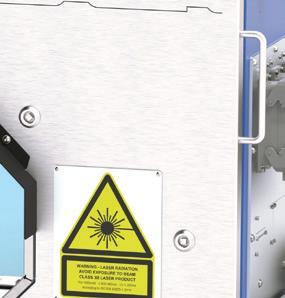

















PROFILEMASTER® SPS
Profile Measuring System
The PROFILEMASTER® SPS is a light section measuring device for measuring contours and dimensions on profiles of all kinds in cold and hot steel applications.



















Benefits:
Maximum measuring accuracy thanks to temperature-stabilized measuring systems
Shape fault detection (SFD) thanks to high sampling rate
High-precision measurements
Detects process problems at an early stage
Fast maintenance and easy cleaning
Zumbach Electronic AG | Hauptstrasse 93 | 2552 Orpund | Schweiz Telefon: +41 (0)32 356 04 00 | Fax: +41 (0)32 356 04 30 | sales@zumbach.ch | www.zumbach.com 4 - 8 Number of cameras min 5 Min. object diameter (mm) max 720 Max. object diameter (mm)



Not only that, just 1% of these projects are under construction, with 75% only in the very early stages of development according to BNEF. IEEFA expects that most of these projects will never reach construction.




Even the International Energy Agency (IEA), which has long claimed there will be a major role for CCUS going forward, appears to be starting to rethink.
In the 2023 update to its net zero emissions (NZE) scenario it stated, “So far, the history of CCUS has largely been one of unmet expectations. Progress has been slow and deployment relatively flat for years... This lack of progress has led to progressive downward revisions in the role of CCUS in climate mitigation scenarios, including the 2023 NZE Scenario.”

Also in November, the Global CCS Institute (GCCSI) released its 2023 Global Status of CCS report. The GCCSI is tracking 41 operational commercial-scale CCUS plants and 351 in development globally. Of nearly 400 projects, only four are in the steel sector, including the operational Al Reyadah project in the UAE and two others in the early stages of development.


existing CCUS facilities, the captured carbon is used for enhanced oil recovery (EOR). Enabling the combustion of more fossil fuels is clearly not a climate solution.
For steel decarbonization the IEA’s updated 2023 NZE scenario reduces CCUS’s role to 37% of steel production by 2050, down from 53% just two years ago. Meanwhile, hydrogen-based steelmaking’s role increases from 29% in 2021 to 44% in the 2023 update. IEEFA expects that that the IEA will continue to reduce emphasis on CCUS for steelmaking going forward.
British Steel’s announcement regarding its shift from blast furnaces to EAFs provided another recent data point indicating CCUS’s trajectory. The company made clear it had looked into decarbonizing its blast furnaces – which presumably would have to heavily involve CCUS – but found it ‘not viable’.
The inability of CCUS to play a meaningful role in steel decarbonization will mean an industry shift away from coking coal and towards DRI and trade of HBI is on the cards. Key questions include how much iron ore trade will be replaced with HBI trade and how quickly?
Despite its perceived success as the only commercial-scale CCUS project in the steel sector worldwide, the Al Reyadah project actually exemplifies the technology’s problems.
Designed to capture emissions from Emirates Steel Arakan’s DRI plants, the project was commissioned in 2016, but in the following seven years no other commercial-scale CCUS facility for steel has been completed anywhere. In addition, the project only captured around 30% of Emirates Steel Arkan’s DRI carbon emissions in 2022. Can a steel plant with that kind of capture rate really be regarded as decarbonized?
Finally, and in common with most
Meanwhile, a role for CCUS to decarbonize blast furnace-based steel operations looks even less likely.
In June 2023, the German think tank Agora Industry found that, since 2020, commercial-scale project announcements for DRI and for CCUS for blast furnacebased steelmaking have developed very differently. To date, virtually all steel companies that plan to build low-carbon steelmaking capacity at commercial scale have opted for hydrogen-based or hydrogen-ready DRI plants, not CCUS.
The 2030 project pipeline of DRI plants has grown to 84Mt, while the pipeline for commercial-scale CCUS on blast furnacebased operations amounts to just 1Mt according to Agora.
European steelmakers are currently focused on starting their own DRI operations that will eventually run on green hydrogen. However, with some recent issues with green hydrogen development and funding in Germany, might there be a rethink towards the import of truly green HBI from more ‘advantaged energy locations’ as the impact of Europe’s carbon border adjustment mechanism (CBAM) spreads?
The sudden and chaotic restructuring of the UK steel industry, which will cause thousands of job losses, should be a warning to other nations. Pressure to decarbonize the steel industry will only grow and looks set to significantly impact the geographical structure of steelmaking and steel raw materials trade globally.
Going forward, governments around the world will need to get onto the front foot to plan a more orderly transition towards a new steel industry structure. �
DECARBONIZATION 31 www.steeltimesint.com March 2024
Decarbonizing in 2024: from both sides of the pacific

IN 2023, there were significant developments in the fight to decarbonize the steel industry from trading partners across the globe. From the implementation of the Inflation Reduction Act (IRA) in the United States (US) to the beginning of reporting under the Carbon Border Adjustment Mechanisms (CBAM) in the European Union (EU), governments and industry have been acting on emissions. However, more must be done if the steel industry is going to comply with the IPCC’s 2050 targets.
As 2023 drew to a close, the steel industry witnessed a transformative development - Nippon Steel’s proposed acquisition of US Steel. As the world grapples with the urgent need to decarbonize, the choices made in boardrooms and policy chambers in Japan now reverberate across the Pacific to impact the American steel industry and, by extension, our shared commitment to a sustainable future.

Japan is the world’s third-largest steel producer; however its steel industry relies on coal for nearly 75% of production. In the coming years, steelmakers in Japan will decide whether to reline or retire the country’s 20 operating blast furnaces with a combined capacity of 125Mt/yr. At least 11 of these furnaces have been operating for more than 12 years since the last relining, so steelmakers will be faced with critical
* Senior director, Mighty Earth
decisions soon.
Japan’s two largest steelmakers, Nippon Steel and JFE, continue to pursue outdated, coal-based strategies that delay the needed transition. As recently as 2023, Nippon Steel made new investments in coal mining, invested in new blast furnaces in India as part of a joint venture, and insists that coal-based steelmaking remains essential in the decades ahead. Its insufficient decarbonization plans centre on using hydrogen in blast furnaces and carbon capture. The second-largest steelmaker, JFE, is pursuing carbon recycling at blast furnaces and CCUS. But it is also beginning to close and replace blast furnaces with new EAFs in Japan. It plans to import directly reduced iron using natural gas to reduce emissions compared with ironmaking using coal.
Powerful domestic lobbies, including the automotive, steel, and electric power industries, resist changes to their business models and push for decarbonization
DECARBONIZATION 32 www.steeltimesint.com March 2024



As the calendar turns over to 2024, the global steel industry has one less year to reach the Intergovernmental Panel on Climate Change’s (IPCC) 2050 net-zero emissions targets to limit the severity of global warming. With steel accounting for 11% of greenhouse gases (GHGs) annually, decarbonization must continue to be a key area of focus for the industry, governments and civil society. To meet climate goals, steel emissions intensity must drop 93-100% by 2050 as global steel demand is projected to grow 30%. With that increased demand and to stay on a trajectory to net zero by 2050, the world needs 70 new green steel plants by 2030 and continued investments and policies taken by the industry and governments. By
Matthew Groch*



without disruption. In 2022, the government of Japan rebranded its decarbonization initiatives as a $1 trillion ‘green transformation,’ or ‘GX,’ policy aiming to transform economic and social systems to structures driven by clean energy.
The GX policy is overly influenced by industry. It focuses on initiatives that aim to reconcile existing fossil fuel-based infrastructure with the national goal of achieving net zero emissions by 2050. This includes injecting hydrogen into coalbased blast furnaces and broad adoption of carbon capture, utilization, and storage (CCUS). Analysts have panned these plans as expensive, unworkable, and yielding insufficient emissions reductions.
A decarbonized electric grid is essential to reduce emissions from electric arc furnaces (EAF) and to produce domestic green hydrogen. However, Japan’s GX policy has been criticized by other G7 member states for its reliance on ammonia as an energy source because ammonia production relies heavily on fossil fuels. Under its revised hydrogen roadmap, hydrogen production
will be based on fossil fuels (‘gray’ and ‘blue’ hydrogen) in the near term, making climate emission reductions uncertain. Steel companies have stood in the way of clean energy policies in Japan, with InfluenceMap noting the industry’s active lobbying against carbon pricing and the renewable energy feed-in-tariff incentive.
The Japanese government’s ‘CCS LongTerm Roadmap’ sets the storage capacity at 120-240Mt annually by 2050. The steel industry’s decarbonization strategy is reliant on carbon capture and will require approximately 47Mt/yr of storage by 2050. However, the government’s 2050 scenario has power generation using 250Mt of storage, leaving nothing for steel. The logistics of transporting and storing huge

quantities of CO2 domestically still need to be solved. Much of the CO2 may be exported to countries in Southeast Asia, incurring additional costs and questions of feasibility.
Steel buyers have been nearly silent, with no Japanese corporate members of ResponsibleSteel or SteelZero to date. Many automakers, led by Toyota Motor Corporation, have resisted electrification and have no plans to address supply chain emissions. One noticeable exception is Honda Motor Company, which signed a broad agreement to pursue decarbonization strategies with relatively forward-looking Korean steelmaker POSCO rather than its long-time Japanese steel suppliers.
Ultimately, Japan must make difficult choices as it is neither feasible nor affordable for all sectors to continue business as usual and adopt fuel switching and CCUS. Renewable energy must be deployed at scale, and green hydrogen should be prioritized for steelmaking and other industrial uses. Japan can work with its iron ore suppliers, including Australia, to build supply chains with hydrogen direct reduction that can completely replace coal and enable near-zero emissions steelmaking.
While Japan grapples with its
DECARBONIZATION 33 www.steeltimesint.com March 2024


Tebulo





















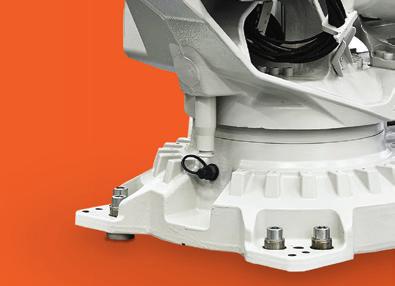
Tebulo Robotics creates high quality robot applications that are the solution for making industrial processes faster, better, safer, cleaner and more productive.



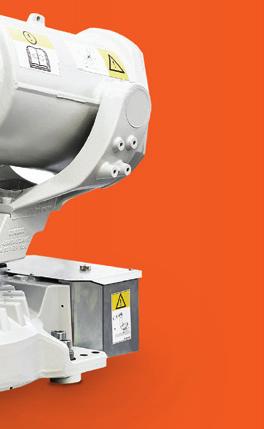




CREATING ULTIMATE SOLUTIONS tebulorobotics.com
& Labelling
& Slabs
Marking
Coils
Destrapping of High Strength Steel Straps
Dross
Removing
Sample Plate Handling
& Specials
Robotic
Strapping Product Handling
Robotics specializes in the design and supply of innovative robotic solutions that operates under extreme conditions. With our many years of experience, knowledge in technology and driving forward advancements in engineering and robotics, we are able to offer a wide range of superior solutions that accelerate industrial processes.
Meet us at AISTech 2024, in Columbus Ohio. 6-8 May, Booth 1315

decarbonization strategy, American steelmakers have a unique opportunity to lead the charge toward greener steel production. Funding from the IRA and Bipartisan Infrastructure Law could propel US primary steelmakers ahead in the global race for green steel. Potential buyers are starting to line up with the automotive industry, and other major steel customers are increasingly signalling their demand for green steel. Despite these favourable tailwinds, recent announcements like Cleveland-Cliffs’ plans to reline multiple blast furnaces, risk steering us away from a climate-safe trajectory. The time is ripe for transformation but demands leadership and climate-aligned decisions from integrated steelmakers US Steel and Cleveland-Cliffs.
Substantial federal funding is a starting point for transitioning to cleaner steelmaking. Later this month, the Department of Energy will reveal whether iron and steel projects have been prioritized in the $6.3 billion funding for industrial demonstration projects. This programme could be instrumental in paving the way for the USA’s first low-carbon primary steel facility. Paired with the Hydrogen Hub programme that is moving forward in all of the key iron-making regions of the country, the Biden Administration has paved the way for private reinvestment with public dollars.
The Hydrogen Hubs aim to create networks connecting hydrogen producers, consumers and local infrastructure to make hydrogen delivery and storage more efficient. If the hubs can produce new, renewable energy hydrogen, they could spur the transition to green ironmaking in the US. However, the proposals in ironmaking states currently rely on methane gas with carbon capture and storage (CCS). As the DOE continues funding negotiations, involving workers and communities and increasing the supply of green hydrogen are all prerequisites to a just and equitable
transition to green steel.
Against this backdrop, major players like the automotive industry are signalling a substantial demand for green steel to clean up their supply chains. General Motors CEO Mary Barra recently highlighted the company’s pursuit of increased green steel availability to shareholders and urged the steel industry to bolster production. This demand became even more evident through the launch of a joint request for 2Mt of

low-carbon steel issued by companies like Microsoft, Trammell Crow, and Nextracker via RMI’s Sustainable Steel Buyers platform. European steelmakers are already preparing to meet this building demand. If the US
industry fails to invest, they will miss out on the green steel premium and risk losing customers to green, foreign competition.
The momentum fuelled by federal funding and increased demand for green steel underscores the potential for transformation. However, the industry’s reliance on coal-based blast furnaces poses a significant threat to achieving climate goals and meeting market demand. While blast furnace steelmaking represents only 30% of steel production in the US today, it is responsible for a disproportionate nearly 70% of climate pollution. To secure their place in the evolving landscape, US steelmakers must accelerate investments in near-zero-emissions steelmaking. If Nippon Steel successfully acquires US Steel, it is imperative for them to swiftly transition away from blast furnace steelmaking if they hope to meet demand for low-carbon steel.
Over the next decade, demand for lowcarbon steel is expected to increase by 113%, reaching $364.5 billion by 2032. To reduce carbon emissions in the heavy industry sector, steel producers need to develop and implement transition plans that move them away from polluting production methods. That means investing in the technologies with the most significant emissions reductions, such as direct reduced iron and green hydrogen. It is also important that steelmakers do not prolong fossil fuel-based steelmaking by avoiding relining blast furnaces and rejecting CCS and CCUS technologies that are unlikely to result in significant emissions reductions.
With more action needed to limit warming to 1.5 degrees and global demand for low-carbon steel surging, now is the time for global leaders to work with steelmakers and major steel consumers to transition to sustainable steel production. �

DECARBONIZATION 35 www.steeltimesint.com March 2024

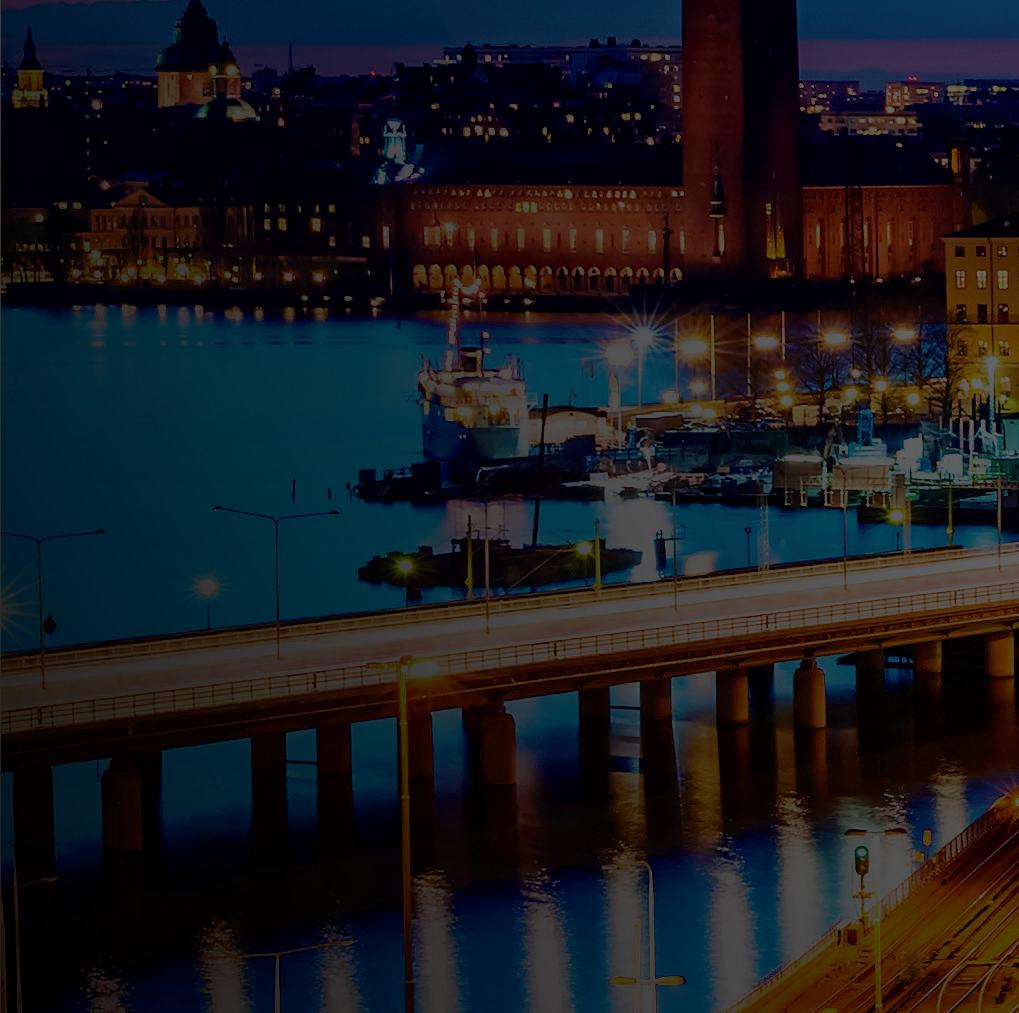







Early bird tickets now available
The Future Steel Forum was launched to address the growing interest in digital manufacturing within the global steel industry, particularly the technologies associated with industry 4.0 such as Big Data, the Industrial Internet of Things, Artificial Intelligence and Machine Learning.Over the past five years, the event has attracted speakers from major steelmakers including ArcelorMittal, Tata Steel, Voestalpine, POSCO, Emirates Steel, US Steel, Big River Steel, Liberty Steel Group, TMK, Kobe Steel, Metinvest
Digital, Badische Stahl-Engineering, Buderus Stahl and many others. Future Steel Forum speakers tend to be involved in the development and/or use of systems that rely upon these technologies, and the event itself endeavors to attract a mixed audience of steelmakers and technologists. In a nutshell, the Forum is an event for forward-thinking steelmakers who embrace new high-tech production technologies that embody the essence of so-called “smart manufacturing”.
Visit our website to discover more about the event www.FutureSteelForum.com








for a limited time only!
SPONSOR OR EXHIBIT
Do you want to showcase or promote your products and services to over 200+ international steel professionals? Discover what opportunities we currently have available by contacting Paul Rossage on paulrossage@quartzltd.com
FOR LIMITED TIME, SECURE YOUR EARLY BIRD TICKET/S HERE, AND SAVE UP TO £200PP



EVENT SPONSORS:







O cial Media Partner Organised by
@Future_Steel Join our Future Steel Forum Group
Nant de Drance: a gigantic rechargeable battery
Generating electricity when the sun does not shine or the wind does not blow poses a challenge for the world’s transition to renewable power. A twist on a century-old technology offers an elegant solution. Pumped storage hydropower uses gravity to store massive amounts of green energy and generate electricity on demand. At Nant de Drance in the Swiss alps, molybdenum-alloyed high-strength steels are crucial to keep electricity flowing. By
AMONG renewable energy sources, solar and wind are considered the most viable to reduce greenhouse gas emissions by 2050, according to the International Energy Agency. However, the availability of both depends on the course of nature, making electricity supply variable, unlike that from fuel-burning power plants. For instance, if a very windy day produces more power than needed, that power is wasted without adequate storage. A mismatch in supply and demand puts communities at risk of black-outs or power surges. Hydropower storage, also known as pumped storage, offers both a solution and an alternative to massive utility-scale battery banks. When there is excess electricity in the power grid, it is used to pump water from a lower reservoir into a second reservoir at a higher elevation, like recharging a giant battery. When demand necessitates, the water is released and uses gravity to drive a turbine, producing electricity. Currently, pumped storage is the largest battery technology by far, representing over 90% of all installed energy storage capacity globally, according to the International Hydropower Association. The amount of energy stored in the world’s hydropower plants dwarfs all traditional batteries on earth combined, including all electric vehicles (EVs).
Building a plant in the Swiss alps
Pumped storage isn’t appropriate for every environment: droughts, for example, can severely compromise the system’s function. Hydropower technology can also affect sensitive ecosystems. And there must be a significant elevation difference for water to fall from: the greater the difference, the more energy efficient. But in areas
Karlee Williston*

SPECIAL STEELS 38 www.steeltimesint.com March 2024
* Editor, MolyReview


with ample space, water, and mountains where a height difference can be exploited, pumped storage offers immense potential to compensate for fluctuations in power supply and demand. According to the Australian National University, there are over 600,000 sites potentially suitable for pumped storage systems worldwide.
A good use case for pumped storage lies in Switzerland, which already generates nearly all of its electricity with carbonfree hydro and nuclear power. Around 60% comes from hydropower and an additional 35% comes from nuclear.
Though the country has among the lowest carbon emissions in electricity generation worldwide, its ability to transition away from nuclear generation to renewables depends on large-scale storage solutions. Bringing Nant de Drance online provides storage capacity, generates low carbon electricity, and adds system flexibility. The plant is crucial not only for stabilizing the Swiss grid but also for the European electric grid at large. For example, if a wind farm in
NANT DE DRANCE IN NUMBERS
900MW: generating capacity
6: Francis turbines, each with a capacity of 150MW
20 Mio. kWh: storage capacity ~400,000 EV batteries
194m: length of the underground turbine chamber
25 million m3: capacity of Vieux Emosson reservoir ~20 hours of electricity
Germany produces an excess supply, that energy can be transferred and stored at Nant de Drance.
Two existing reservoirs with a significant height difference inspired this project in the Valais alps. The reservoirs are connected by a pair of gargantuan 2 km-long parallel conduits called “headraces”. These include the 425-metre high vertical shafts, some seven metres in diameter. The two pipes transporting water through the headrace, known as ‘penstock,’ are concrete-lined and reinforced with high-strength steel in the areas of higher stress. Components exposed to the highest stresses use molybdenumcontaining S690 QL1, a quenched and tempered steel. This includes the pipe elbows leading into and out of the vertical shaft, their flanges, and the reinforced distributors at the bottom of the shaft that supply the six turbines. Some of the areas of highest stress utilize S690 QL1 plate as thick as 130 mm, containing up to 0.7% molybdenum. Housings for the gates that help control inflow and outflow at either
end of the headrace are also made with this steel. The force of the water crushing down is enormous – but heavy-duty plate steels can handle it. Especially if they’re alloyed with molybdenum.
What makes the steel strong?
When the required yield strength of a plate steel surpasses 500 MPa, molybdenum becomes important, especially for thicker plates. When quenching a steel plate after heat treating at high temperature, the centre of the plate cools more slowly than the surface, a phenomenon that becomes more pronounced as steel sections become thicker. This variation in cooling is problematic because it results in inconsistent steel strength across the thickness. Molybdenum is very valuable in thicker steel plates because it helps to homogenize the steel’s strength profile across the thickness of the plate.
Molybdenum is, therefore, a key hardening element in high-strength penstock. The steels involved in pumped
SPECIAL STEELS 39 www.steeltimesint.com March 2024
Inside a reinforced distributor. It divides each large diameter penstock into three branches, feeding one turbine each.




Cooling bed sampling robot

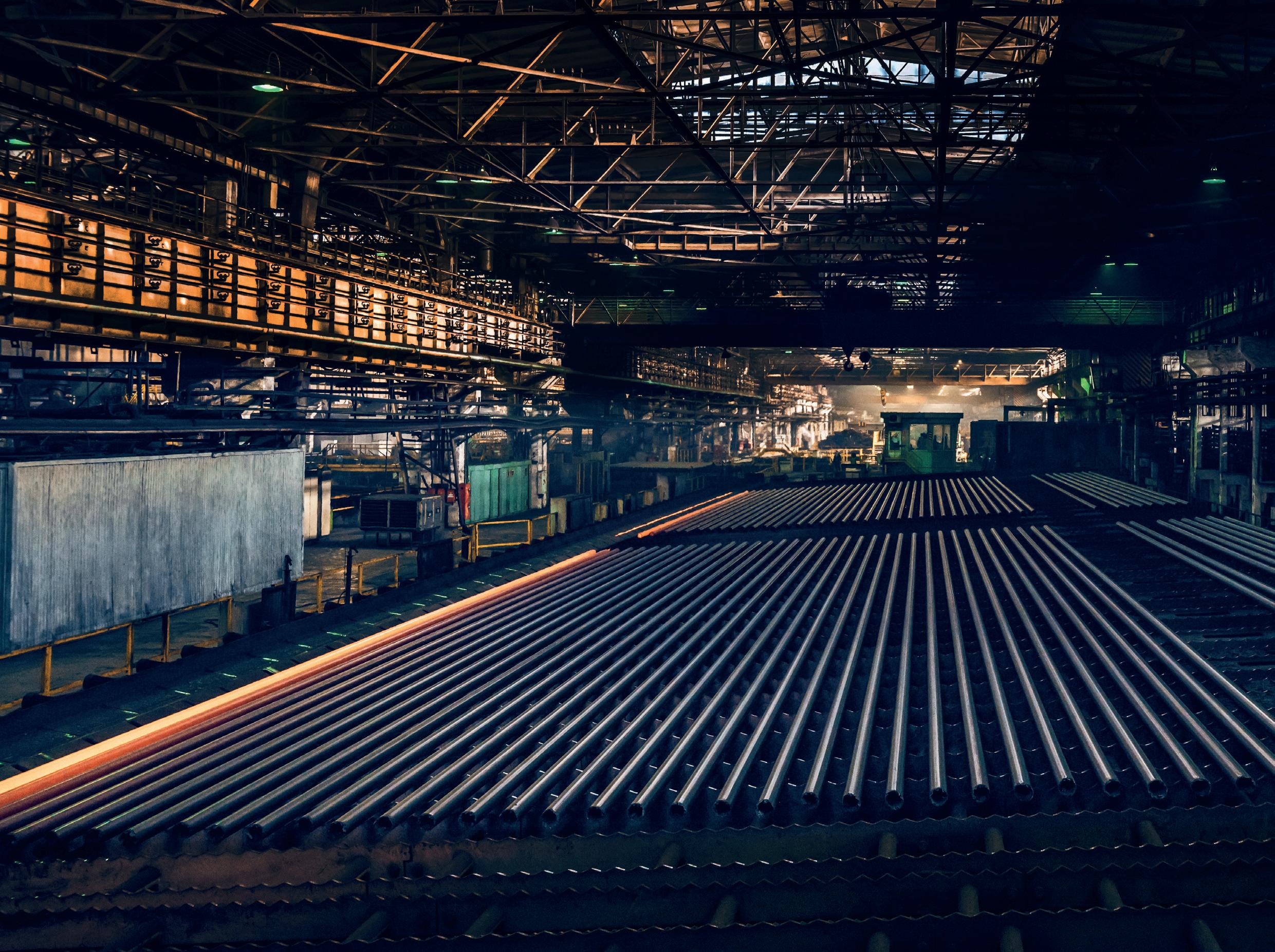

ELECTRICAL AND AUTOMATION SYSTEMS
Wire and Tube

DISCOVER OUR SOLUTIONS
INDUSTRIAL ROBOTICS AND INTRALOGISTICS
15-19 April 2024 Düsseldorf, Germany
Booth 7AC17 – 7AB11
AISTech
6-9 May 2024 | Columbus, USA
Booth 2415
SEAISI Steel Mega Event
13-16 May 2024 | De Nang, Vietnam
MECHATRONICS AND PLANT ENGINEERING
MEET US AND JOIN OUR COMMUNITY

NEW! PolyTEST WE
THE STEEL INDUSTRY ATTRACTIVE FOR FUTURE GENERATIONS
MAKE
polytec.bmgroup.com | sales@bmgroup.com
storage plants are thick plates that need to be exceptionally hard, strong, and tough, but also weldable. Molybdenum helps heavy duty steels develop an ideal balance between hardness and toughness. Strength usually comes at the expense of toughness, a measure for a material’s ability to absorb impact. Imagine a piece of glass, something very hard, also needing the properties of something highly shock absorbent like rubber. Strong steel can be tempered – a form of heat treatment – to increase toughness, but then the material usually loses some of its desired strength. Molybdenum, however, largely prevents the loss of too much strength during tempering and maintains toughness. During tempering, molybdenum precipitates by itself or jointly with other elements such as chromium and micro alloys, to form what are known as “nanosized carbides” , which are essentially very hard, microscopic particles in the microstructure. These microscopic particles dispersed in the microstructure are responsible for secondary hardening. When steel is heated and cooled according to carefully designed time-temperature schedules, its microstructure can be adjusted to a wide variety of phase constituents, grain sizes, and other structural features resulting in wildly different properties. Molybdenum plays a major role in controlling the phase formation and particularly promoting
strong microstructures.
Nant de Drance: excellent energy efficiency
With its 900 MW of installed generation capacity, around as much as a typical nuclear reactor, the Nant de Drance plant is one of the most powerful in Europe. It operates at over 80% efficiency – among the highest achieved in pumped storage power plants, and far above traditional thermal power plants. For example, coal-fired plants average just over 33% efficiency. They can also take hours to reach full operation. Nant de Drance, on the other hand, can start up in two minutes and go from pumping to generating in less than five minutes, so it can react to any spike in demand or drop in supply almost instantaneously.
Because Nant de Drance will so greatly improve the Swiss grid’s ability to react to rapid changes in power supply and demand, the country’s famous railway system, SBB, became a shareholder in the project. SBB’s trains are fully electrified, requiring as much electricity as Switzerland’s largest city, Zurich. However, power demand for the rail system varies dramatically throughout the day, peaking to several hundred MW in the early morning when locomotives all over the country power up nearly simultaneously. Demand also surges every half hour when

trains leave the stations according to the synchronized train schedule.
But where exactly is all the massive equipment hidden within the pristine peaks of the Swiss Alps? Well, the entire plant is built inside a mountain. Hiding so much of the storage plant’s structure within the mountain not only preserves stunning views of the Alps, but also reduces its impact on the local ecosystem. Over 17 km of tunnel were dug into the mountain using a huge tunnel boring machine. One 5 km tunnel leads to the gaping subterranean engine room, where the turbines are housed. Though it is 600 m below ground, the room is so large, the Leaning Tower of Pisa could comfortably fit inside! Most of the welding of the massive steel pipes and other components took place on site in caverns. The construction of the plant spanned 14 years and operation began in July 2022. The world’s transition to clean energy will be challenging. The inherent variability of supply requires massive energy storage systems. However, solutions are developing, and some are already available, like hydropower storage. Nant de Dance is an example of successful large-scale energy storage, made more reliable and longer lasting through the special properties of molybdenum-alloyed high-strength steels. Once again, molybdenum is instrumental in a technology poised to meet the world’s energy demands more sustainably. �

SPECIAL STEELS 41 www.steeltimesint.com March 2024
The massive penstock is reinforced with high-strength steel in the areas of highest stress like the elbows
Installation of a pump turbine. The turbine blades are made of martensitic stainless steel, containing 0.3 –1.0% molybdenum
Supervisory control systems for the future

Advanced data analytics allows us to better understand how industrial processes work and the monitoring and control required to complete them successfully. The digitalization of production equipment using Internet of Things (IoT) technology gives us access to an unprecedented amount of data, from which predictive models for process optimization can be developed. By Mojca Loncnar*1,
Matjaz Demšar4
SIJ Acroni upgraded the electric arc furnace in its steel mill and the ZRM cold rolling mill by applying the functionalities of digital factories and Industry 4.0 concepts. In the H2020 project called INEVITABLE, supervisory control systems have been developed for two demonstration sites which belong to SIJ Acroni (EAF and ZRM), making it possible to optimize the operation of the production process, improve productivity, and reduce energy and raw materials consumption.
SIJ Acroni is a modern recycling steel plant that uses secondary raw materials. [1] We are one of the most efficient steel
producers globally in terms of carbon footprint, as measured by the World Steel Association. Following our decarbonization plan, by 2030 we will reduce CO2 intensity by 51% [2,3]. Digitalization is a strong part of our decarbonization strategy, as is improving various performance indicators by retrofitting existing production sites with the use of digitalization and innovative high-level supervisory control technologies.
SIJ Acroni is an industrial partner in the INEVITABLE project, and in this role has provided two demonstration sites for digital transformation – an electric arc furnace (EAF) and Sendzimir cold rolling
mill (ZRM) – with the aim of developing a fully digitalized monitoring technology to enable improved and optimized manufacturing processes. For this purpose, predictive models have been developed that are combined with smart and networked sensor technologies to correlate process parameters with quality indicators of the manufactured products. This combination has resulted in EAF and ZRM supervisory control systems that enable more effective and efficient operation of energy and resource-intensive manufacturing processes
[4, 5] Fig 1
*Corresponding: mojca.loncnar@acroni.si
DIGITALIZATION 42 www.steeltimesint.com March 2024
1 SIJ ACRONI d.o.o., Jesenice, Slovenia, 2 Institut Jožef Stefan, Ljubljana, Slovenia
3 Univerza V Ljubljani, Ljubljana, Slovenia, 4 Siemens d.o.o., Ljubljana, Slovenia
Zdravko Smolej1, Dejan Gradišar2, Miha Glavan2 Vito Logar3 Igor Škrjanc3

1 Optimization framework for an electric arc furnace (EAF) at SIJ Acroni SIJ Acroni produces steel exclusively from steel scrap. In an EAF, such scrap is heated and melted by the heat of electric arcs striking between the furnace electrodes, a process that is energy-intensive. Due to the absence of online measurements of some crucial EAF process values, such as the stage of scrap melting, bath temperature, and so on, the EAF operators must act according to other available measurements and, most importantly, their own experience, which usually leads to suboptimal operation.
The optimization framework for EAF was thus developed to improve practice by enhancing the melting profiles and estimating the unmeasured process variables. It combines online models for process simulation and optimization, and offline models for evaluation, scenario testing and process optimization, as outlined below.
Online models – the EAF refining monitor is a soft-sensor which continuously estimates the crucial process values (ie. bath temperature and dissolved oxygen content)


in the refining stage of melting [6]. These variables are physically measured only three or four times per heating. The EAF refining monitor uses the measured input EAF feeds (i.e. transfer power, carbon injection and oxygen lancing) to estimate bath temperature and dissolved oxygen content. The resulting process values of interest to furnace operators are shown on screens that are part of the existing SCADA system. By using the refining monitor the operators can get more detailed insights into the conditions in the EAF, thus enabling more precise control of the system.
Offline models – EAF process models and optimization combine a comprehensive theoretical EAF model based on fundamental physical laws and the corresponding mathematical equations with a fuzzy modelling approach, which can be successfully applied if enough process data is available for the parameterization model and data-driven models [7]. The theoretical EAF model was designed in a modular manner, where each important part, ie, I/O data handling and reading of the melting programme, model constants,
condition-dependent coefficients, chemical reactions, energy transfers, mass transfers and so on, was implemented in a separate module. Such a design also facilitates the verification and validation of each module, its replacement if a certain module should be enhanced or developed in greater detail, as well as the adaptation of the model to any other EAF. The functionality of the theoretical model was extended by introducing data-based models to enhance the prediction accuracy of theoretical models or extend the range of estimated variables. The structure of the fuzzy model is significantly simpler in comparison to theoretical models, as there is very little or no physical background included. Second, the parameterization of these models is based on only a few measured process data and is automated, thus significantly reducing the effort for model development. For offline EAF process models and EAF optimization, dedicated user interfaces were developed in the frame of the Siemens Visual Flow Creator (VFC) platform, each of which is customized for the features of the solution. The interface for the
DIGITALIZATION 43 www.steeltimesint.com March 2024
Fig 1. Two demonstration sites for digital transformation – an electric arc furnace (EAF) and Sendzimir rolling mill (ZRM)
Fig 2. Digital solutions developed for EAF operation support

offline EAF model allows the user more opportunities to define the input variables, as well as making comparisons of the results of several consecutive simulations (with modifications in input variables). The interface for EAF optimization is simpler, since the tool underneath it does not have that many input variables, ie, charging information (scrap types and weights), transformer power, oxygen lancing, carbon addition, and a user-defined goal which the optimization tool will pursue.
For both solutions all data transfers between the user interface and the Edge PC (hosting the solution) are carried out through the MQTT protocol. By using the EAF optimization framework (offline EAF process models and EAF optimization) in offline mode, it is possible to quickly assess the differences in either charging of the EAF or its control, and thus modify the operation of the EAF to achieve greater efficiency. Fig 2
1.1 System for supervision, optimization, diagnosis, and condition monitoring of cold rolling mills
Cold rolling is a continuous high-speed deformation process, in which metal is passed through the rolls at temperatures below its recrystallization temperature. It is part of the production chain for SIWATT non-oriented electrical steels, the most important materials that are used for electricity transmission in energyefficient electrical appliances. SIWATT steels are currently used in the magnetic cores of electric motors, generators and transformers, and in the future they will be used in hybrid and electric cars [6] However, the appropriate final quality of the rolled strips can only be achieved with the properly managed technological process of the cold rolling of coils, using a
predefined rolling plan where the optimal reference rolling thickness is set. To improve production quality and productivity of the ZRM – by increasing line speed, reducing reversing time between passes and faster ramp-up and ramp-down – as well as increasing reusability by reducing the possibility of strip breakage, an advisory system has been developed as a powerful tool for process optimization and control of cold-rolled strips.
The main prerequisite for further digital upgrading of the system was complete retrofitting of the process, in which the basic automation of the ZRM was upgraded. The improved process insights that were thus obtained enabled the development of a new system for supervision, optimization, diagnosis, and condition monitoring of cold rolling mills. This system incorporates the decision support solution and enables both the adjustment of rolling parameters and the condition monitoring solution.
The recipe adaptation and optimization tool makes suggestions considering best practices from the past and applied to current conditions and requirements, taking into the account the basic principles and relations among the measured process variables. The decision support system internally integrates several different data processing algorithms and models, using first principles and a data-based modelling approach. This approach uses neural networks and Gaussian process models to describe the relationships among the selected rolling recipe parameters and their impacts on variations in the exit thickness. Adopting a similar approach, a model describing the relation among the set initial rolling force and the time needed to stabilize the rolling force has been developed. The solutions provide feedback

before the rolling is initiated (when used in an offline manner) and after each rolling pass (when used in semi-online operation). With semi-online monitoring the ZRM monitoring algorithms are triggered after each rolling pass. Prior to that, data from one rolling pass is collected and after the rolling operation is completed the collected data are analysed in batches to look for anomalies within the last completed pass. Dedicated user interfaces (UI) were developed in the frame of the Siemens Visual Flow Creator (VFC) platform. The system gathers the necessary data from the cloud storage repository and the MES system and then constructs a REST analytics call. Finally, the resulting suggestions are shown on the UI. The decision support tool provides a method for continuous improvement of the production process while learning from the previous historical process and conditions. Such a databased approach enables the translation of historical best practices to new, similar conditions, and so improves current practices with a more flexible and limited set of rolling recipes.
The condition monitoring solution is partly based on first principle models. The model parameters were identified through a process of optimization, in which the observed and simulated responses were minimized. The condition monitoring solution combines several models: friction hill and rolling load model, steel transmission model, DC drive model and X-ray measurement model (mass flow and measurement repeatability). The dedicated UI was developed in the frame of the Siemens Visual Flow Creator (VFC) platform. The interface for monitoring cold rolling equipment monitors the datastream resulting from edge calculations and triggers alarms that can be reviewed,

DIGITALIZATION 44 www.steeltimesint.com March 2024
Fig 3. Digital solutions developed for the ZRM process
analysed and resolved through the interface. The condition monitoring system allows the maintenance team to continuously monitor the ZRM equipment and reacts immediately when an anomaly appears, which can prevent strip breaks and longer technological stoppages. Fig 3
2 Conclusion
Within the INEVITABLE project various supervisory control systems have been developed for two demonstration sites at SIJ Acroni (EAF and ZRM) that allow for optimizing the operation of the production process, improving productivity, and reducing the consumption of energy and raw materials. The optimization framework for EAF continuously estimates the crucial process variables for the refining stage (the bath temperature, active oxygen) and estimates unmeasured variables such as the stage of scrap melting, electrical and chemical energy input, and total energy balance of the EAF, thus improving the EAF process. The system for the supervision, optimization, diagnosis, and condition monitoring of cold rolling mills to achieve process optimization of the ZRM suggests



the rolling recipe parameters prior to rolling, advises the operator on the rolling parameters between two rolling passes and provides monitoring of crucial parameters (thickness gauge, DC drives, defects of rotating elements such as rollers, etc.), leading to improvements in product quality, productivity, and energy efficiency.
The method presented here combines digital upgrades of the processes and adoption of supervisory control systems in order to achieve more sustainable and environmentally friendly steel production.
Acknowledgment
The work presented in this paper is funded by the European Union’s Horizon 2020 research and innovation programme, the SPIRE initiative, under Grant No. 869815, and the INEVITABLE project (“Optimization and performance improving in metal industry by digital technologies”).


References
[1] www.acroni.si
[2] https://www.sij.si/en/sustainability/ environment/ (access: 7.8.2023)
[3] Sustainable Development Strategy 2022-2023, Group SIJ, 2022.
[4] https://inevitable-project.eu
[5] D. Gradišar. Optimising performance in the metal industry, Projects magazine, Issue 43, Insight media, 2022.
[6] A. Blaži, I. Škrjanc, V. Logar. Soft sensor of bath temperature in an electric arc furnace based on a data-driven Takagi–Sugeno fuzzy model. Applied Soft Computing. 113:B, 2021.
[7] S. Tomaži, G. Andonovski, I. Škrjanc; V. Logar, Data-Driven Modelling and Optimization of Energy Consumption in EAF, Metals, 2022.
[8] https://www.sij.si/en/sij-brands/siwatt/ (access: 7.8.2023)
[9] K. Cuznar, M. Glavan. Optimization of cold rolling process recipes based on historical data, MELECON 2022.
[10] P. Ettler, M. Glavan. Detection and isolation of oscillation sources in cold rolling mills, IFAC-PapersOnLine, 2022.


45
25 combilift.com Enhance the Safety, Storage & Efficiency of your logistics with Combilift Combilift’s range of multidirectional forklifts, pedestrian reach trucks, straddle carriers and container loaders will allow you to maximize the capacity, improve efficiency and enhance the safety of your facility. Contact Us Today To find out how Combilift can help you unlock every inch of your storage space. UNLOCK EVERY INCH OF YOUR STORAGE SPACE!
Given all the headwinds and conflicting factors that have recently been impacting the US energy pipe and tube market, it is hard to get a handle on where the markets for both oil country tubular goods (OCTG) and line pipe are likely to go from here.
By Myra Pinkham*
SOME energy pipe and tube market participants are predicting a slight upturn in demand this year while others are much more bearish.
“It has been a wild ride with chaos being the only consistency over the past year,” Kurt Minnich, vice president for pipe and tube at Argus Media said, predicting that could also be the case in 2024. “It will require constant monitoring of all the market and political drivers and pricing trigger points.”
Others, however, are a bit more upbeat. For example, Luca Zanotti, Tenaris’ US president, termed demand for energy tubulars as being in a healthy state despite the ongoing market volatility.
In fact, Kim Leppold, head of steel research at Fastmarkets, notes that even though rig counts and capacity expenditures by oil field operators are not expected to be much higher than they were last year, 2024 OCTG demand is expected to be fairly steady and even potentially up slightly, partly because the count of drilled but uncompleted (DUC) wells has fallen to a multi-year low.
At the same time demand for line pipe is being bolstered by the need for additional natural gas transmission pipelines to go from the West Texas/Permian Basin to the US Gulf Coast, where a number of liquified natural gas (LNG) export terminals are being built, Leppold said. She noted, however, that elsewhere permitting for pipeline projects remains slow.
The underlying demand for energy pipe and tube – particularly OCTG – however, is much more of an oil story, Rick Preckel, a partner at Preston Pipe, said, noting that in February about 65% of drilling activity was for oil.
The percentage of OCTG used to drill
Where to from here?

for oil is even higher, according to Tommy McCartin, a principal economist with S&P Global Market Intelligence, who said that, given the amount of horizontal drilling, about 80% of US OCTG is used for drilling crude oil.
“Drilling activity is usually a function of the price of crude oil and natural gas and the expectations of where those prices are going,” Preckel said, noting that when prices go up the exploration and production (E&P) companies will try to produce more.
However, McCartin pointed out that since peaking in November 2022, US drilling activity has come down quite a bit – falling about 25% with the Baker Hughes US drill rig count going from about 780 rigs to 620-625 rigs in February.
While the drill rig count isn’t quite as good an indicator of OCTG demand as it once was due to certain operational changes – such as increased pad and horizonal drilling and the drilling of deeper, longer wells – at least in a short-term comparison the trend for OCTG demand still corresponds with that of the drill rig count, which, Phil Gibbs, a senior metals equity analyst for KeyBanc, observed, had
*USA correspondent
been off to a strong start early in 2023 before fizzling out later in the year.
Most industry observers are expecting 2024 to be somewhat of a stable market for OCTG – either slightly up or down –year-on-year.
While there are many factors that influence OCTG demand, Zanotti said the primary thing is the price of oil and natural gas, which, he pointed out, has been very volatile recently on the back of various geopolitical risks and global tensions on top of the objectives of the OPEC+ nations.
Preston’s Preckel pointed out that that there has been a lot of volatility in the market ever since the COVID-19 pandemic, but that one big impact upon energy prices, therefore drilling activity, was Russia’s February 2022 invasion of Ukraine, occurring in synch with the end of the pandemic. As a result, by June of that year WTI oil prices went up to about $114 a barrel.
“It is hard to know if we would have seen oil prices go up without Russia’s invasion of Ukraine,” Preckel said. But once it became evident that Russian oil wasn’t going away the US made a big release of oil from their
TUBE AND PIPE 46 www.steeltimesint.com March 2024

strategic reserves. As result, oil prices have come back down and have recently been fluctuating between $70 and $80 a barrel, which Gibbs calls somewhat of a sweet spot as that price isn’t overly penalizing to consumers but is high enough to the E&P companies.
Minnich said that while there have been some predictions that oil prices will remain largely steady through 2025, confidence in such forecasts has been limited “with oil prices responding to the whims of OPEC+ members, adverse US government policies and geopolitical problems that impact normal trade routes.”
Natural gas prices have been following a similar pricing trend as oil, going from about $8 per MMBtu in mid-2022 to under $3 per MMBtu early this year. Tenaris’ Zanotti attributed that to a combination of oversupply and delays of certain LNG export facility startups. This comes at the same time as natural gas targeted drilling activity is down about 28% from a year ago, Minnich noted.
Given these dynamics, S&P Global’s McCartin said OCTG prices have been declining ever since late 2022 when they peaked at about $3,700 a short ton. By the fourth quarter of last year, they had

already fallen to about $2,100 per ton and continued to weaken – albeit at a slower pace – early in 2024.
“There, are, however, signs emerging for price support later in this year,” Minnich observed. For example, iron ore, hot rolled coil (HRC) and scrap steel costs are

pressuring energy pipe margins. Also, he said that with such a low DUC count, especially in the Permian basin, new wells must be drilled to maintain or grow domestic production, which will improve OCTG demand. Preston’s Preckel noted that last year 12,000 wells were completed in the US even though only 11,000 were drilled.
Just how much impact raw material prices are having or will continue to have upon energy pipe is somewhat uncertain. Fastmarkets’ Leppold said that while HRC prices have been volatile given some unplanned mill outages, there weren’t any real shortages. She said plate prices have been elevated given the slow ramp-up in plate capacity. “Nevertheless, energy pipe producers have been able to maintain their margins at a high level over HRC and plate,” Leppold said.
Helped by the fact that the US is the leading oil producer worldwide, Zanotti said he doesn’t see US OCTG demand waning anytime soon. He admits, however, that there are some challenges, including how his company and other producers can contribute to the efficiency of the oil and natural gas industry. “For that to take place we need long-term capital investments in the US. And to ensure these investments are rational, we need certainty of the rules of the game and a level playing field.
Leppold said that while the US Section 232 tariffs and quotas, as well as other trade actions, are limiting import volumes from certain countries like South Korea, supplies from domestic and other sources remain adequate to meet current demand.
“But OCTG imports continue to be an issue for the domestic industry,” given that they currently account for nearly half of the US market, Zanotti, who is also chair of the newly formed US OCTG Manufacturers Association, said. He explained, that as American energy production is a matter of national security, we must promote and develop reliable, domestic supply chains, such as a world class US OCTG industry and advocate for more fair trade tools and laws.”
“Line pipe is a little bit of a different animal than OCTG,” KeyBanc’s Gibbs said, noting that while it also follows the energy cycle it tends not to be quite as hypercyclical.
In fact, Preckel pointed out that over the past year overall US line pipe shipments
TUBE AND PIPE 47 www.steeltimesint.com March 2024













CONNECTING THE INTERNATIONAL STEEL INDUSTRY Magazine
Steel Times International is the key publication for the steel market, reporting on iron and steel making issues from all corners of the globe.
Directory
The Steel Times International Directory is the essential guide to steel manufacturers, producers, suppliers of plant equipment and services to the steel industry. Order your print or digital copy priced from £105 or subscribers.
Website
Packed with information on the steel industry and continually updated with news for steel professionals, www.steeltimesint.com features special articles and interviews with leading industry gures.
Newsletter
A round-up of the top news stories is sent to more than 7,000 industry professionals each week. You can register online to receive the weekly newsletter and keep up-to-date with the latest news from across the steel manufacturing industry. www.steeltimesint.com/e-newsletter
Online Events

Since 1866 BUSINESS MEDIA LTD PUBLISHED BY FIND OUT MORE AT STEELTIMESINT.COM Join the Steel Times International Group @SteelTimesInt



have been pretty stable. That, however, has varied by type with smaller diameter line pipe, which is closely related to drilling, being weaker, while there have been some gains in larger diameter pipe, particularly for pipelines that are used to feed the expanding liquified natural gas export capacity.
There could continue to be moderate gains even with the Biden administration pausing any new permits for additional US LNG export facilities and even though transporting natural gas to those facilities only requires short pipelines that tie into other nearby pipelines.
S&P Global’s McCartin noted that seven


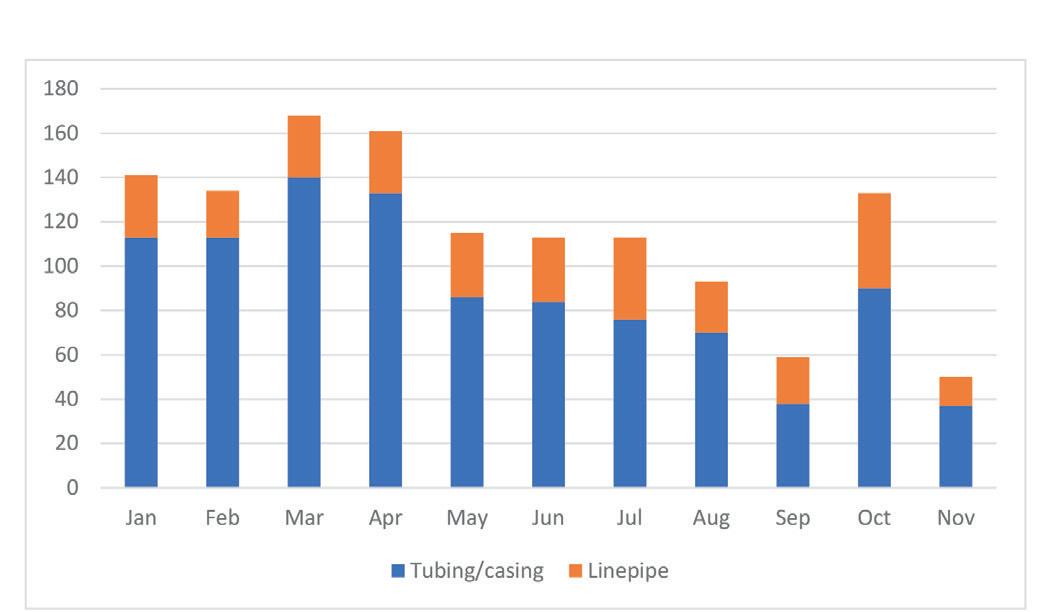
LNG export facilities have come online between late 2020 and the end of 2023 and another four export facilities are expected to come online in 2024 or 2025.
He explained that even with the pause on new permits, anything that has already been approved can go ahead, be constructed and start exporting while the pause will likely affect the market in 2027 and beyond.
Meanwhile the amount of larger pipeline projects has been muted, Preckel said, noting that isn’t surprising given the big build-out in 2019-20.
Leppold agreed, observing that permitting of pipelines has been an issue
for years. She noted that not only is it a very long process to get a pipeline approved, but many times during its construction, issues pop up to slow progress.
“We see favourable conditions in the US energy pipe and tube market despite the ongoing market volatility,” Zanotti said, noting that drilling efficiencies, longer laterals and reduced inventories on the ground should result in a more balanced market in 2023.
Leppold agreed, noting that while demand is not expected to be much higher than it was in 2023, OCTG and line pipe prices could start to rise in the second half of the year. �
TUBE AND PIPE 49 www.steeltimesint.com March 2024
USA: Average monthly number of active rotary rigs by market. Source: Baker Hughes
Strong solutions, strong business
Woodings’ ‘wide spectrum’ of services works to offer efficiency and productivity in a market full of opportunities, says Rob Woodings*.
1. How are things going at Woodings? Is the steel industry keeping you busy?
Currently our business is very strong and has been for the last two years. We are going into 2024 with a strong backlog and steady order intake across our industry segments. This includes mini-mills, integrated mills, and power generation.
2. What is your view on the current state of the global steel industry?
The current state of the industry is good. We have not focused on our international sales for the last five years because we are working hard to meet our domestic demand in North America.
3. In which sector of the steel industry does Woodings mostly conduct its business?
We operate primarily on the hot end of the business in both minimills and integrated mills. We have engineering operations, manufacturing operations, and field services and construction, so we cover a wide spectrum.
4. Where in the world are you busiest at present? North America.
5. Can you discuss any major steel contracts you are currently working on?
We are currently working on several large BOF projects, several blast furnace relines, and two major tilt platform upgrades for two minimill customers.
6. Where does Woodings stand on the aluminium versus steel argument? We like steel.
7. What are your views on Industry
4.0 and steelmaking and how, if at all, is Woodings using it?
We are thoughtfully watching.
developments and working with our customers to meet their needs.
8. Hydrogen steelmaking appears to be the next big thing. What’s your view?
We are working with our customers for hydrogen implementation in their blast furnaces. We are also involved with a first stage company that has successfully developed a process for the recovery and reduction of fines for metal production.
9. In your dealings with steel producers, are you finding that they are looking to companies like Woodings to offer them solutions in terms of energy efficiency and

sustainability? If so, what can you offer them?
Our overlaided hood systems offer state-ofthe-art energy efficiency. Our non-recovery coke plant technology represents the most modern, energy-efficient technology.
10. How quickly has the steel industry responded to ‘green politics’ in terms of making the production
*President and CEO, Woodings Industrial and Munroe Inc.
process more environmentally friendly and are they succeeding or fighting a losing battle?
I believe the industry is working hard on solutions and after 35 years in the business and watching steady progress, I believe that the industry will continue to improve. However, modern industrial societies need steel, and the industry can only go at the speed of available technology.
11. Where does Woodings lead the field in terms of steel production technology?
We have a strong engineering group that works hand-in-hand with our customers on a daily basis. We are presented with challenges and work to develop real solutions that offer long-term value to our customers.
12. How do you view Woodings’ development over the short-tomedium term in relation to the global steel industry?
We are very strong. Due to our beginningto-end solutions, we feel that we are in a good position to meet the challenges.
13. China dominates global crude steel production. How should the industry react to this situation?
The industry should be thoughtful about the challenges China represents. Due to the governmental nature of steel production in China, governments should be alert to and react to distortions.
14. What is Woodings’ experience of the Chinese steel industry?
We have worked in China since 2000 and have been involved in multiple projects there. Additionally, we have several joint ventures in China.
15. Where do you see most innovation in terms of production technologies – primary, secondary or
PERSPECTIVES Q&A: WOODINGS 50 www.steeltimesint.com March 2024
Rob Woodings
more downstream?
Due to the high energy and raw material content of the primary end, this is where the biggest challenges and opportunities exist.
16. How optimistic are you for the global steel industry going forward and what challenges face global producers in the short-to-medium term?
Due to the critical nature of the steel, we are very optimistic. Oversupply and state intervention are the biggest challenges.
17. What exhibitions and conferences will Woodings be attending over the next six months?
We will be attending the annual AISTech conference in Columbus, Ohio, this May.
18. Woodings is headquartered in the US; what’s happening steel-wise in the country?
Steel is going strong. There is a divide between integrated and minimill operations, but these are positive. The North American industry is blessed with high quality raw material, low energy costs,
developed transportation systems, and strong end markets.
19. Apart from strong coffee, what keeps you awake at night? War.
20. If you possessed a superpower, how would you use it to improve the global steel industry?
I would like to see less governmental interventions in the market. �


www.steeltimesint.com March 2024 PERSPECTIVES Q&A: WOODINGS 51

A vanished plant Part 2,1900 -2009
Part 1 of this article, published in STI Jan/Feb 2024, followed the establishment of the Calan ironworks in Transylvania (present day Romania) in 1867 until its change of ownership in 1898 to the ‘Mining and Steelmaking Society of Calan – Kalaner Bergbau und Hütten AG – Kaláni Bánya és Kohó Rt.’ In this the second part of the story Romulus Loan* looks at the plant’s history from 1900 to 2009.
IN 1901, the useful volume of furnace No 1 was doubled from 82m3 to 163m3. Furnace No 2 was idled at some time between 1901 and 1903 and restarted in 1913, when No 1 furnace was demolished.
By 1906, the air blast was preheated to 793°C and this was increased in stages to 950°C by 1913, a significant temperature for those times. Iron production reached 24,178kt that year, an output only exceeded in 1950 when 29,114kt were produced. 1,117 people worked at the Calan ironworks in 1916.
Between 1911 and 1924 ownership changed again, this time to the Rimamuranj and Salgotarjan Metallurgical Plant Society. Iron production had fallen rapidly from 24.1kt in 1913 to 2.8kt in 1916 and the furnace was closed in 1918, iron production not restarting until 1934.
After 1918, like the other enterprises and metallurgical plants of the Rimamuranj and Salgotarjan group, Calan continued to work on its own account, settlements being made to the management in Budapest.
On 21 May, 1924, the Calan works again changed ownership to Titan, Nadrag, Calan SAR. Modernisation of the plant commenced once the economic depression of 1929-1933 had passed and continuation
of construction of a hydroelectric plant re-commenced. In 1927, the Calan works employed 40 clerks, engineers, and foremen

and 671 workers. The increase in the factory’s staff, compared to 1918, is mainly due to the enlargement of the foundry. Foundry workers began a strike in July 1926 causing the foundry to close for a while.
On 30 October 1929, a major fire brokeout and destroyed the dust cleaners, the assembly workshop and power plant, along with a warehouse. The following year saw resumption of activities with the casting of tubes and, for the first time, central heating radiators. In 1933, manufacture of boilers
for central heating began and preparations were made for the manufacture of sanitary ware and bathroom taps. Output from the foundry saw a noticeable increase in 1933 and reached a peak output of 9.8kt in 1935.
Also in 1933, the reconstruction of furnace No 2 and construction of a new blast furnace started as well as further work to complete the hydroelectric plant on the Strei river. For this, a dam, previously built on the Strei, upstream of Rusi, was used to take water along a 4.2km channel to the Strei-Sângiorgiu hydropower plant. Generating capacity was to be 480kWh.
The new furnace used the site of the first furnace built in 1871, and used local materials and personnel. The furnace started operations in November 1934. Pig iron production was intended for use at both the Calan and Otelu Rosu steelworks. Following start-up, pig iron output experienced large fluctuations peaking in 1943 at around 24.9kt but then falling rapidly in 1945 to around 9kt (Fig 1). About 21.5%, of output was for war production from 1939 to 1945.
Production of semi-coke by fluidisation was put into operation in 1957. Known as the Carofluid furnace, this was a
www.steeltimesint.com March 2024
52 HISTORY
*Dr Ioan is executive director of the Resita steelworks, part of Artrom Steel Tubes
The management of the plant in Calan and some of the workers from the furnace and foundry.
Calan ironworks, Romania, post 1934
development by Romanian engineers to produce coke by semi-carbonisation of non-metallurgical coals as the first stage of producing metallurgical coke. In 1961, an experimental coke-briquetting station was started. The coke-chemical sector consisted of nine Carofluid furnaces to produce coke and semi-coke, with a capacity of 250kt/yr, and a 40kt/yr plant for the production of coke briquettes.
During 1971-1975, through the construction of new units, coke production was further developed and modernisation of the works continued. Four blast furnaces operated by 1975, two of 250m3 useful volume and two of 1,000m3 useful volume.
The name ‘Victoria-Calan’ was introduced in 1956, the works by then was the largest producer of grey cast iron in the country and was the main supplier of rolls for rolling mills and casting machines for the neighbouring Hunedoara and Resita steel plants. In addition to the workshop for the production of mill rolls, there was also a sector for casting various small parts with a capacity of 52kt/yr as well as a 60kt/yr plant for maintenance and repairs. A foundry for

cast iron radiators and sanitary parts (taps, pipes for sewage, drain covers, etc.), with a capacity of 75kt/yr was established.
In 1989, the Calan steelworks had around 6,400 employees. In 1990, the combine was transformed into the Sidermet Calan Trading Company. In 1998, this was divided into 12 commercial companies which were privatised as 12 subsidiaries, on the site of the former steel works.
Profitability of the former combined company, now SC Sidermet SA, went from bad to worse. By 2009, only three

commercial companies of the 12 were still operating, employing just 300 workers. More than 200 worked at the foundry, now ‘Cilindrul SA Calan’. In Autumn 2003, Sidermet Calan entered a winding-up procedure because of debts, amounting to US$1.5M to the state budget alone. Part of the company’s assets were sold, and others recovered as scrap metal.
The concrete structure of the former production halls are, today, a desolate landscape, which can be seen from the DN66 highway. �
In TIG welding, the focus is entirely on achieving a high weld quality. In doing so, it is just as important to maintain a stable arc at all times as it is to have a wide range of functions on the welding system. The Artis-170/210 generation masters this balancing act perfectly, combining both in a compact, robust system design.
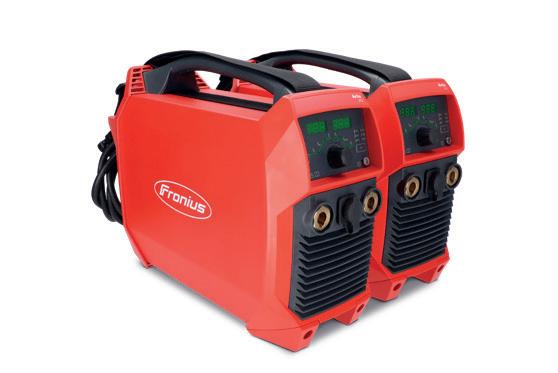
www.steeltimesint.com March 2024 HISTORY 53
Fig 1. Production of Pig Iron and cast iron parts 1924-1947.
When you´ve got
your
For more details, please visit: www.fronius.com/artis Increased arc stability to unleash your welding potential. Artis 170 | 210
no second try, it´s all in
hands.




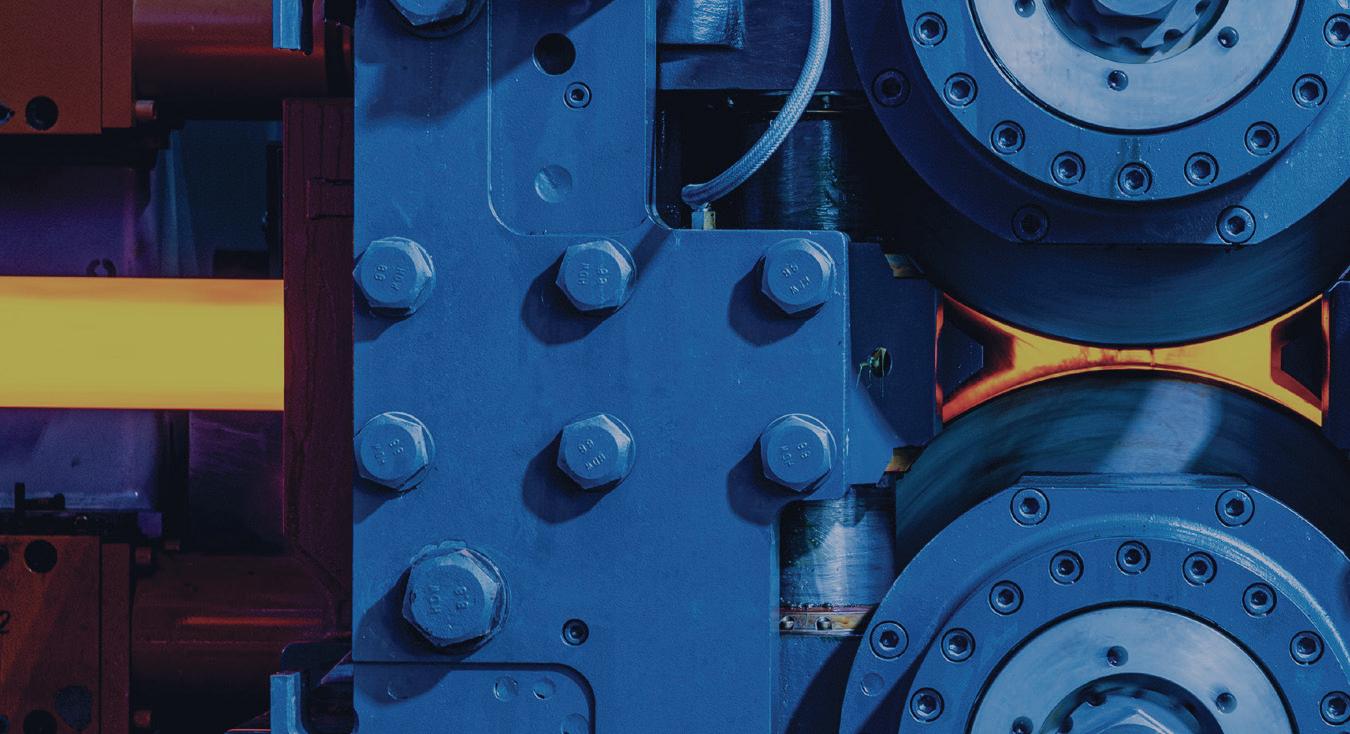
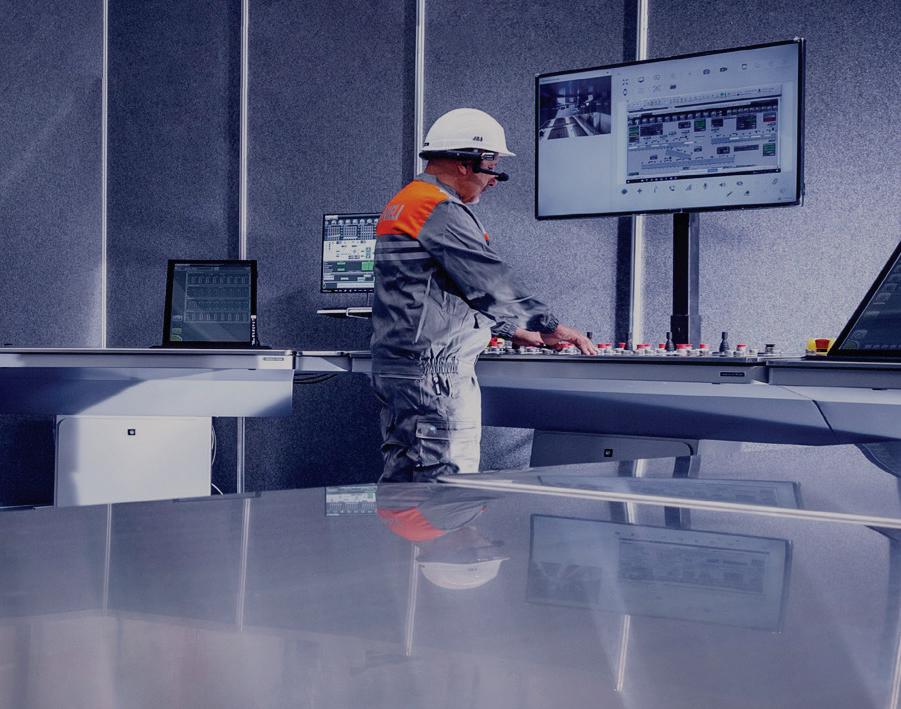




DANIELI AUTOMATION metals complexity www.dca.it simplifying Via Bonaldo Stringher, 4 33042 Buttrio (UD) Italy Phone +39 0432 518 111 www.digi-met.com www.dca.it Follow us on Linkedin












 Matthew Moggridge Editor matthewmoggridge@quartzltd.com
Matthew Moggridge Editor matthewmoggridge@quartzltd.com






























































































































































































































































































































































































































